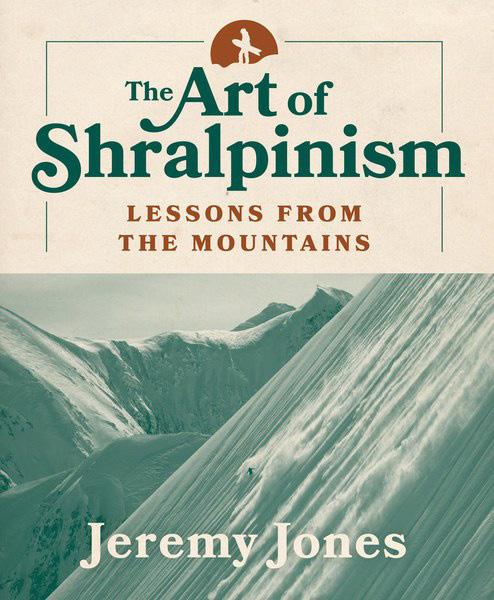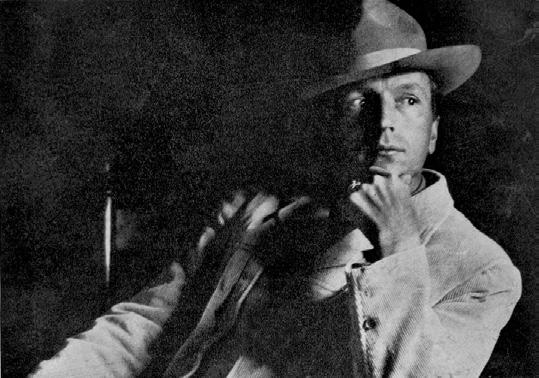
We are hikers on remote trails. We are alpinists navigating rock and snow. We are pioneers on hostile summits. We span seven continents and a thousand landscapes but our intent is the same. For every trail, for every mountain, for every moment. We are Explorers.

Location - Washington Pass, USA
Athlete - Nathan Hadley

WWW.RAB.EQUIPMENT
MAZAMA BULLETIN

Volume 105
Number 2
March/April 2023
CONTENTS
FEATURES
Landscape Painters and the Early Years of the Mazamas, p. 10.
An Evening with George Cummings in His Ceramics Studio, p. 19.
The Alano Club of Portland & the Mazamas, p. 24.
Mazama Artists, p. 27.
Surfing in Narnia, p. 34.
IN THIS ISSUE
The next step is to hire a new Executive Director. The passage of the bylaws opens us up to a broader candidate pool because the Mazamas are positioned for growth and innovation," p. 7.
When the Mazamas formed in the late nineteenth century, the Pacific Northwest was about as far from the center of the Western art world as one could imagine," p. 10.
COLUMNS
Mazama Membership, p. 5.
Interim Executive Director’s Message, p. 6. President’s Message, p. 7.
Upcoming Courses, Activities, & Events, p. 8.
Editorial Note, p. 9. Successful Climbers, p. 23.

Mazama Classics, p. 23.
Book Review, p. 25.
Board of Directors Minutes, p. 37.
Colophon, p. 39.
MARCH/APRIL 2023 3
Cover: "Illuminated Rock" by Sarah Lydecker, cover by Elise Englert. Above: New member Sarah Clay on the summit of Mount St. Helens, March 30, 2018.
MAZAMA VALUES
RESPECT
We believe in the inherent value of our fellow Mazamas, of our volunteers, and of members of the community. An open, trusting, and inclusive environment is essential to promoting our mission and values.
SAFETY
We believe safety is our primary responsibility in all education and outdoor activities. Training, risk management, and incident reporting are critical supporting elements.
EDUCATION
We believe training, experience, and skills development are fundamental to preparedness, enjoyment, and safety in the mountains. Studying, seeking, and sharing knowledge leads to an increased understanding of mountain environments.
VOLUNTEERISM
We believe volunteers are the driving force in everything we do. Teamwork, collaboration, and generosity of spirit are the essence of who we are.
COMMUNITY
We believe camaraderie, friendship, and fun are integral to everything we do. We welcome the participation of all people and collaborate with those who share our goals.
COMPETENCE
We believe all leaders, committee members, staff, volunteers, and participants should possess the knowledge, skills, abilities, and judgment required of their roles.
CREDIBILITY
We believe we are trusted by the community in mountaineering matters. We are relied upon for information based on best practices and experience.

STEWARDSHIP
We believe in conserving the mountain environment. We protect our history and archives and sustain a healthy organization.
4 MAZAMAS
MAZAMA MEMBERSHIP
DECEMBER Membership Report
NEW MEMBERS: 15
Max Berezhnyy, Mt. Hood
Chris Boyle, Mt. Jefferson
Tyleen Conrow, Mt. Adams
John Dendiuk, Mount St. Helens
Scott Firstenburg, Mt. Baker
Melanie Greenfield, Mount St.
Helens
Natalie Harvey, South Sister
REINSTATEMENTS: 11
DECEASED: 0
MEMBERSHIP ON DECEMBER 31:
2,397 (2022); 2,480 (2021)
David Jay, Denali
Jacob Kahut, South Sister
Paul Kaufmann, Mt. Adams
Sachi Lake, Mt. Hood
Heather Marsh, Mt. Baker
Jena Novotny, Mount St Helens
Elizabeth Quade, Mt. Hood
Anabella Wilson, South Sister
JANUARY Membership Report
NEW MEMBERS: 57
Hilliary Alway, Old Snowy
Jordan Alway, Old Snowy
Laken Bell, Mount St. Helens
Ryan Bradley, Mt. Adams
Patrick Brandimore, South Sister
Leah Brown, Mt. Adams
Chris Burreson, Broken Top
Brian Campos, Mount St. Helens
Michael Cobb, Mt. Hood
Chris Conley, Mt. Hood
Andrew Conley, Mt. Rainier
Jack Davidson, Mt. Baker
Kaleen Deatherage*
Rob Dietz, Mt. Shasta
Winnie Dong, Mount St. Helens
Maximilian Eline, Old Snowy
Cecilia Estraviz, Mt. Whitney
Amanda Ettaki, Mt. Adams
Ben Fleskes, Mt. Hood
Brayden Goodlin, South Sister
Brookelynn Goodlin, South Sister
Jacob Haag, Mount St. Helens
Chris Hagerman, Mount St. Helens
William Hallgren, Mount St. Helens
Nicholas Hazel, Mount St. Helens
Conor Jackman, Mt. Baker
Kyra Jeffrey, Mt. Baker
Victoria Johnson, Eldorado
Sydney Johnson, South Sister
REINSTATEMENTS: 9
DECEASED: 3
MEMBERSHIP ON JANUARY 31:
2,496 (2023); 2,579 (2022)
Brad Jordan, Mount St. Helens
Joseph Kealy, Mount St. Helens
Sean Lane, Mt. Hood
Jorge Lopez, Mount St. Helens
Leah Madoff, South Sister
Cassie Mapolski, Mount St. Helens
Kate McCarn, South Sister
Jordan McCauley, South Sister
Eva Miller, Mount St. Helens
Tim Minks, Mt. Hood
Hank Mishima, Mount St. Helens
Matt Mudrow, South Sister
Abigail Parrott, South Sister
Kellie Peaslee, South Sister
Theo Pham, Mount St. Helens
Walker Pruett, Gannett Peak
Claire Richards, Mt. Adams
George Rodway, Denali
Ben Scandella, Mt. Shuksan
Sarah Scholz, Mt. Hood
Tom Scott, Mount St. Helens
Daniel Scott, South Sister
Justin Sorensen, Mt. Shasta
John Sullenbarger, Old Snowy
Kyle Tarry, Mt. Hood
Heather Walloch, Mt. Shasta
Jonathan Watkins, Mt. Shasta
Allison Wright, Borah Peak
*First person to join after the Glaciated Peak requirement was abolished.
Top: New members Brayden and Brookelynn Goodlin on the summit of South Sister, August 13, 2022.
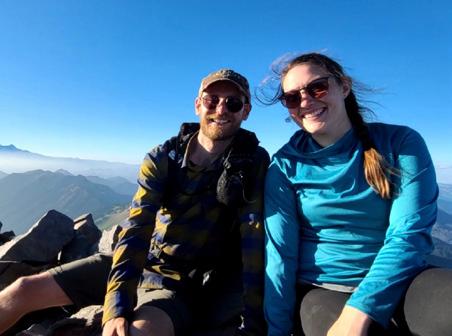
Middle top: New member Rob Dietz on the summit of Mt. Shasta, May 16, 2015.



Middle bottom: New member Winnie Dong on the summit of Mount St. Helens, October 1, 2021.
Bottom: New members Jordan and Hilliary Alway on the summit of Old Snowy, July 24, 2021.
MARCH/APRIL 2023 5
DIRECTOR’S MESSAGE
by Kaleen Deatherage
Ithink January 31, 2023, is the second-most important date in Mazama history, second only to July 19, 1894, when Mazama members founded our organization on the summit of Mt. Hood. Out of so many pivotal dates defining the Mazamas, why does the date we elected to restate our bylaws stand out for me? Because it is the date you gave the Mazamas a pathway to another 130 years of stewarding a love of the mountains and training future generations of outdoor adventurers to hike and climb safely and successfully.
Thank you ALL so much for the time you invested to understand the need for restating our bylaws. Thank you for your efforts to talk with your fellow members and evaluate the proposed changes. And thank you for voting to put the organization on a new route to a vibrant future.
So what comes next? I’d like to suggest revitalizing the Mazama brand to position the organization for growth, and engaging the community by inviting those who have a passion for adventuring in the outdoors to join us. A new strategic plan is needed to prioritize initiatives and focus the organization’s efforts on the outcomes you most need to achieve. To make sustainable progress in these areas, it's time to choose a new Executive Director.
Greg Scott, in his role as Board President, has convened an experienced search committee made up of people who are highly-engaged Mazama members (See "President’s Message" on page 7). They will do a wonderful job of running a professional and equitable process to select our next leader. I am delighted to have the opportunity to serve as a mentor to the hiring process, and I am excited to see the candidates who will apply for the privilege of leading the Mazamas into the future.
Here are a few of the attributes and skill sets that I will be looking for as we choose our next executive leader:
■ Passion for and appreciation of the Mazama mission.
■ Understanding of the role of a servant leader; has the confidence to make decisions, knows when to seek advice, and can inspire staff and volunteers while also holding them accountable.
■ Ability to effectively communicate, demonstrate empathy, and understand others’ viewpoints, as they work toward building consensus.
■ Significant experience with nonprofit budgeting and financial oversight.
■ Commitment to the practice of being a good leader by building agreements through transparent communications, and the clear communication of decisions.
So what comes next? I’d like to suggest revitalizing the Mazama brand to position the organization for growth, and engaging the community by inviting those who have a passion for adventuring in the outdoors to join us.
■ Ability to engage the community to tell a compelling story about the importance of investing in the Mazamas.
■ Proven experience in donor stewardship, legacy giving, making the ask, grant writing, and event management.
■ Ability to authentically continue our efforts to promote diversity, equity, and inclusion with staff and volunteers, coupled with an ability to expand the Mazama community of support, by reaching out to underserved, underrepresented, and non-traditional partners.
The person who takes on the role of Executive Director will play an important part in shaping the future for the Mazamas, but they won’t be able to execute on the organization's strategic priorities alone. Each of you has an important role to play as members, volunteers, and staff to help continue to define the route ahead and to make the journey a successful one. As a newly-minted Mazama member myself, I
look forward to participating in new ways in the months to come. It’s an exciting time to be a part of our organization. Let's continue the journey together.
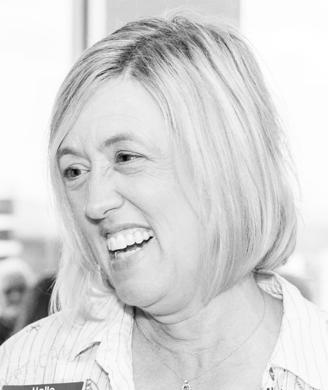
6 MAZAMAS
INTERIM EXECUTIVE
by Greg Scott
Now what? Those of you following along at home know the bylaws are just the first step in the Route Ahead. The next step is to hire a new Executive Director (ED). The passage of the bylaws opens us up to a broader candidate pool because the Mazamas are positioned for growth and innovation. We immediately took action following the election and formed an executive search team. The team includes Greg Scott (board president), Kaleen Deatherage (current interim), Aimee Filimoehala (board member), Claire Tenscher (board secretary), Marty Hanson (board member), Marty Scott (Finance Committee member and prior Search Committee member), Lori Coyner (Mazama member and AAC board member), and Sohaib Haider (Mazama member). By the time this is published, our ED search committee will have created an executive director profile, and hopefully you’ve already seen the job posting. Because we have a tight timeline, we leveraged past information collected from leadership and membership to build our profile.
Meanwhile, the passage of the bylaws immediately impacts the board’s focus on recent access issues and the lodge. The Climbing Committee and Trail Trips Committee are working on the implementation of a new policy and structure for offering climbs and hikes based on the recommendations from the Access Committee. I cannot thank all of these committee members enough for all the work they are doing to build capacity and reshape Mazama programming.
Later this year we plan to kick off a capital campaign to address the needs of the lodge. As part of this initiative, we secured space with the Oregon Historical Society to have an exhibit to celebrate the 100-year anniversary of the Mazamas operating a lodge on Mt. Hood. The exhibit will open in November and is an opportunity we can leverage to fundraise for the lodge and take care of deferred maintenance such as the roof and kitchen and work towards a sustainable operational plan to make the lodge available again.
Finally, although we have not opted to expand the board yet, we have had a few personnel changes. The board approved Chris Jaworski to join our board in December. Chris is filling the final term for an open seat through 2023, and has

already jumped in to work on lodge issues. His background in hospitality is already proving invaluable as we map out an operational plan for the lodge. Additionally, Terry Donahe resigned from the board and as Mazama treasurer. The board approved Liz Crowe to join our board to fill this vacancy. She is now the new board treasurer. Liz was instrumental in creating our new budget process and is already very plugged in to Mazama finances. We are excited to have both Chris and Liz on the board.
There are many other areas I know the membership feels we need to address and plan for, but many of these things will likely need to wait until we have a new ED in place. This includes strategic planning for future IT needs and membership structure. We will begin to form advisory committees to begin collecting information that will inform the future, but we may not immediately see impacts until much closer to the end of the year or next year.
Nonetheless, this moment gives us an opportunity to reflect on what worked well in the last several years and what did not, and take steps toward improving communication. Let’s all use this momentum to work together to build and strengthen the Mazamas.
2023 MAZAMA BYLAWS SPECIAL ELECTION RESULTS
RESULTS: 1,127 (89%) YES, 134 (11%) NO
PROPOSED CHANGE NEEDED 67% TO PASS; MOTION PASSES.
We want to thank everyone for making their voice heard and taking the time to vote in this year’s election. We had a large turnout this year with 1,261 members casting ballots. We are encouraged that more than 52% of members who voted feel that we are proceeding in the right direction with this change.
Unprecedented voter turnout for this special election.
2023: 52%
2022: 27%
2021: 37%
2020: 27%
2019: 21%
2018: 23%
2017: 21%
MARCH/APRIL 2023 7
PRESIDENT’S MESSAGE
The passage of the bylaws opens us up to a broader candidate pool because the Mazamas are positioned for growth and innovation."
UPCOMING COURSES, ACTIVITIES, & EVENTS
CANYONEERING 2023
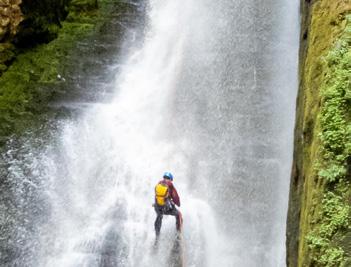
SUNDAY SKILL BUILDERS
Ready to improve your alpine skills?
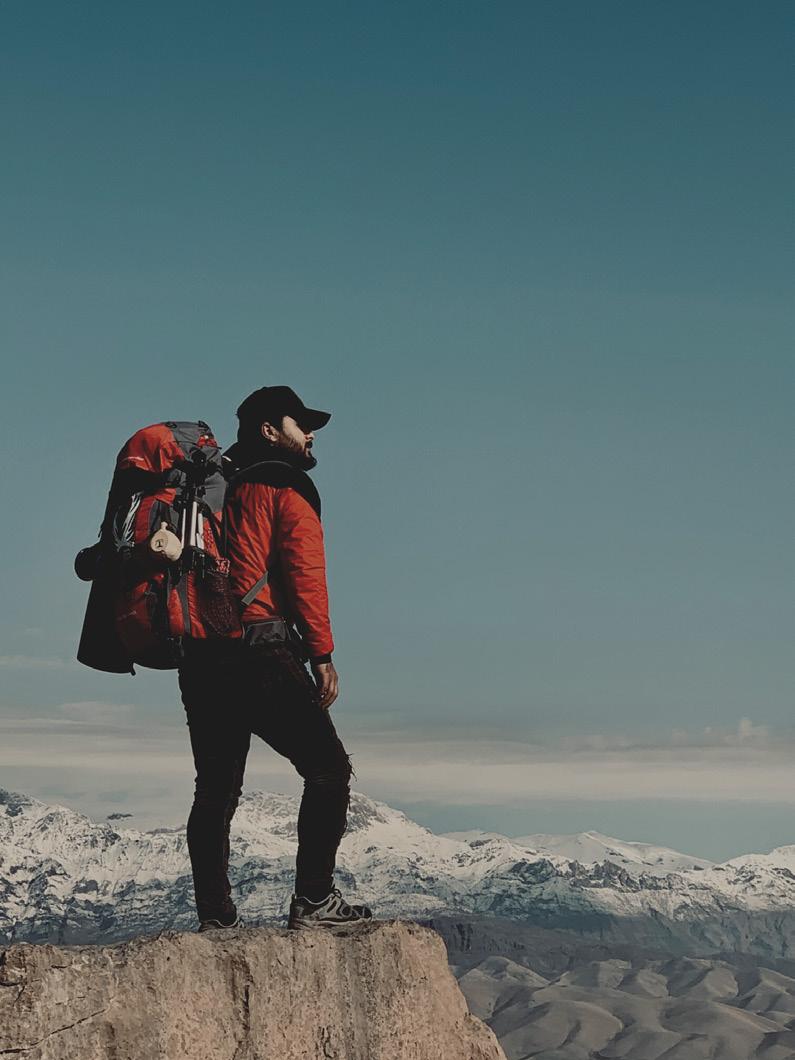
We're excited to let you know about the latest Mazama class series: the Sunday Skill Builder Clinics, new for 2023. These clinics are convenient, consistent, hands-on, bitesized, and inexpensive, with rotating (and repeating) topics.
Upcoming skill builders:
■ March 12–Climbing Knots 101
■ March 26–Advanced Climbing Knots
STREET RAMBLES
Going on a Street Ramble is one of the best ways to get an introduction to the Mazama hiking program. Meet other hikers and plan a weekend trip, maintain your fitness after work, and see some hidden parts of Portland you might never see otherwise. Interested in joining us? All you need to do is show up, check in, pay, and be ready to go at 6 p.m. We'll see you there!
■ Application opens: April 18
■ More info: mazamas.org/canyoneering
This six-week course includes weekly lectures and two field sessions. The lectures will provide an overview of canyoneering, introduce canyon-specific topics and techniques, and prepare students for the class field sessions. An optional, late-summer outing will be offered to course graduates.
The class will focus on local canyoneering in the Pacific Northwest, but we will touch on some of the aspects specific to the sandstone canyons of the Colorado Plateau.
STEEP SNOW & ICE SKILL BUILDER
■ Applications will be accepted
June 1–July 1.

Steep Snow & Ice will once again be hosting the SSI skill builder in August 2023. This curriculum is targeted at intermediate technical alpine climbers who want to gain the techniques and experience to climb routes such as Mt. Hood's Reid Headwall or Mt. Rainier's Kautz Glacier route. We generally have three evenings at the MMC where we discuss hazard assessment and risk management in alpine settings, work on efficiency of our roped multipitch transitions, and learn ice climbing techniques on the artificial ice walls of Holman Auditorium. This is followed by a two-day weekend field session on the glaciers of Mt. Hood during which we practice placing snow and ice protection, building anchors, and refining our movement on steeper ice (35-90 degrees).
■ April 9–Map and Compass 101 and Gaia GPS practice
We operate Tuesday and Thursday night Street Rambles year-round from REI parking garage in the Pearl District (NW Portland).
More info at mazamas.org/rambles
8 MAZAMAS
not your backyard. Spend your weekends in the backcountry, For a free estimate, contact Landscaper/Mazama member: Evan Smith (971)666-4552 landscapedirectpdx@gmail.com
EDITORIAL NOTE
You may be asking yourself, why is the Mazama Bulletin dedicating an entire issue to the arts? It’s a legitimate question and one that we hope to answer for you. The Mazama Bulletin has a long history of publishing and embracing the arts, although not much recently. For many years, decades really, it was common for a poem to grace the front cover of the bulletin. Charles Sholes, a founding member and the first of our two five-term presidents, was a poet and his work graced dozens of bulletins in the publication’s early years.
We know, especially in this day and age, that many of our members are amateur, and in some cases professional, photographers, and we routinely feature their works. But what about the painters, sculptures, authors, and other creatives who call themselves Mazamas? This issue has been many years-in-the-thinking, but really came to fruition, in part, by Peter Boag’s excellent article on the early influence of, and collaboration between, turn of the century artists and the Mazamas. That prompted us to put out a call that you might have seen in these pages asking for members to submit their artistic creations. We are thankful many responded and shared their work. We knew we were on the right track when Kate Evans and Alexandra Howard submitted their article on Geoge Cummings and his pandemic ceramics.

As Mazamas, our love of the outdoors takes many forms, we hope you enjoy this view of the mountains through a different lens.
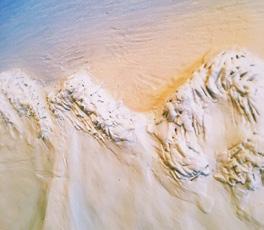 Mathew Brock
Mathew Brock

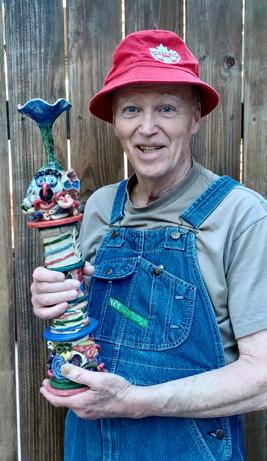 Library & Historical Collections Manager, Mazama Bulletin Editor
Library & Historical Collections Manager, Mazama Bulletin Editor


Mazama Publications Committee
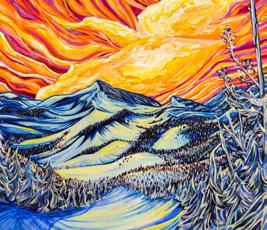
Peter Boag, Elise Englert, Darrin Gunkel (chair), Ali Gray, Ryan Reed, and Claire Tenscher

MARCH/APRIL 2023 9
Mazama
LANDSCAPE PAINTERS AND THE EARLY YEARS OF THE MAZAMAS
by Peter Boag
On August 10, 1890, Fay Fuller (1869–1958), a 20-year-old Tacoma school teacher, became the first woman known to reach the summit of Mt. Rainier, a mountain that was, at that time, locally more often referred to as Mt. Tacoma. Her compelling account—filled with details of perilous ice-climbing, sleeping in a snow cave carved out by the volcano’s steam, frozen boots and hands, and hairpins left behind for future souvenir seekers—was an instant sensation. Newspapers across North America reported it. A few years later, Fuller became a founding member of the Mazamas. She also served as our first historian.
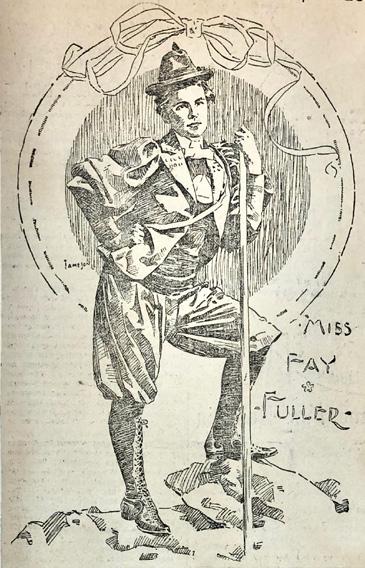

It so happened that during the same summer when Fuller ascended Mt. Rainier, the artist James Everett Stuart (1852–1942) was in Tacoma working and selling his finished canvases to locals and tourists. He had just closed his studio in New York City that spring and was in the process of moving back to the Pacific Northwest. He had grown up in California and had maintained a studio in Portland in the 1880s. During those years, he traveled extensively throughout the region sketching and painting its
scenery. His specialty was the majestic peaks of the Cascade Range. He had also climbed a number of these mountains, sometimes experiencing near disaster in the process. He therefore had a personal appreciation for Fuller’s accomplishment. To demonstrate that, in August of 1890, Stuart painted a lovely image of Mt. Rainier from the Puyallup salt marsh, inscribed on the back of it “to Miss Fay Fuller... for her bravery in being the first Woman who made the ascent of Mt. Tacoma,” and presented it to the now famous climber.
10 MAZAMAS
Above top: Mt. Hood, by William Parrott.
Above: In 1890, Edwina Fay Fuller, at the time a resident and school teacher in Tacoma, became the first woman known to summit Mt. Rainier. She became a founding member of the Mazamas in 1894.
That painting is today part of the Mazama Library and Historical Collection. When the Mazamas formed in the late 19th century, the Pacific Northwest was about as far from the center of the Western art world as one could imagine. And yet at that time art, in particular landscape painting and the local and regional artists like Stuart who produced it, played significant roles in our organization. In a broader sense, regional artists’ infatuation with our mountains was part of the same cultural atmosphere of that time that invigorated mountaineering in the United States. There was a sense among many in 19th-century America that the youthful nation did not measure up, culturally speaking, when looking across the Atlantic to the incredible antiquities and long history that European civilization had to offer. The North American continent, however, provided prideful citizens of the rising United States scenic wonders—at the summit of which stood the West’s loftiest peaks—whose magnificence, in their estimation, surpassed what their oldworld rivals could offer. That much of the
western landscape was an “untouched wilderness” (or, at least in the thinking of the time that ignored the continent’s indigenous people, their rich histories, and their shaping of the land), further reinforced the nationalistic belief that America was the future while Europe was fading into the past. This cultural current flowed through the paintbrushes and onto the canvases of artists such as Stuart. It also contributed to an interest in exploring, climbing, and the preservation of mountains and their environments in the West. These were not only fundamental goals of the Mazamas and its predecessor the Oregon Alpine Club, both whose founding William Gladstone Steel (1854–1934) spearheaded, but of organizations such as the Sierra Club, which John Muir (1838–1914) created in California in 1892.
At least two significant western American artists were early members of

continued on next page
Above top: Louis B. Akin (1868–1913) was an Oregon-born artist responsible for proposing our name “Mazama” and also designing our badge and logo in 1894. As an artist, however, he was best known for his paintings that depicted the desert Southwest. He died in Flagstaff, Arizona. Credit: The Craftsman XXIII, no. 6 (March 1913): 677.
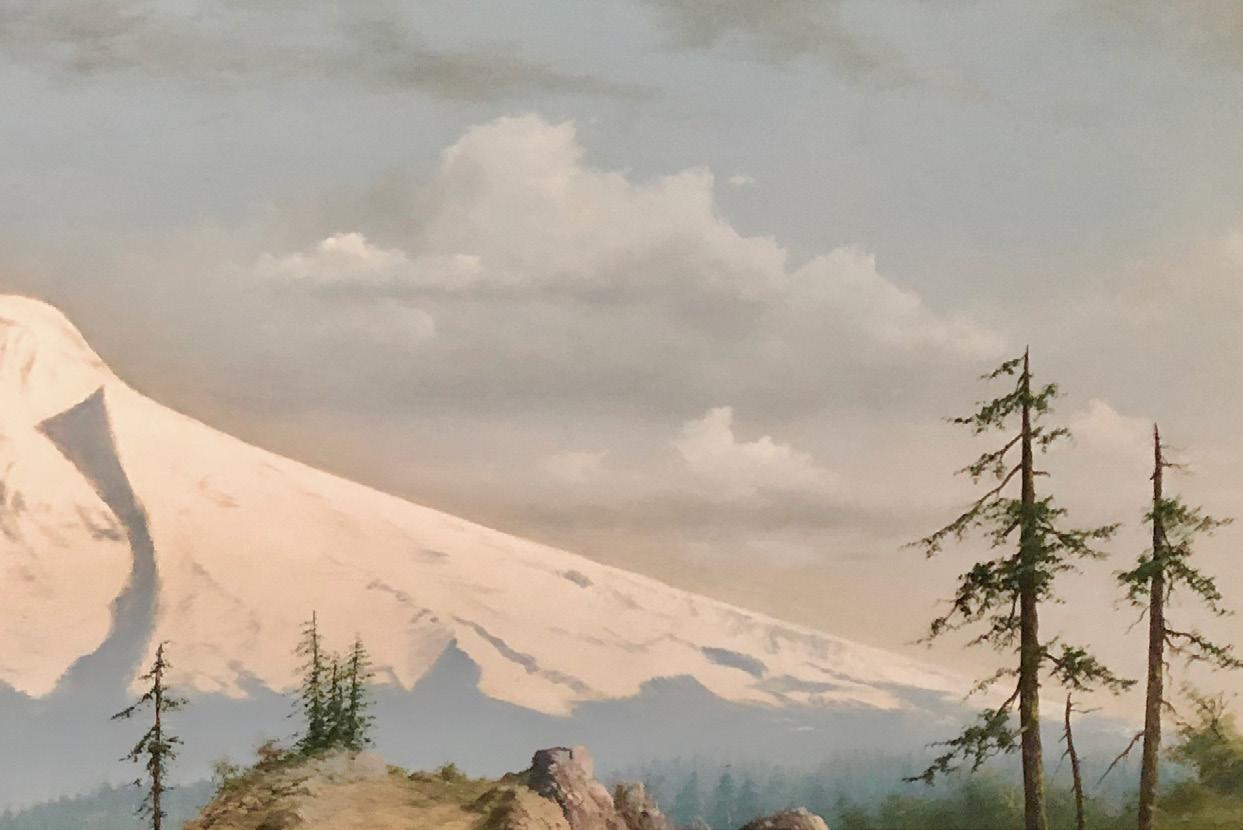
Above: The first issue of Mazama, which is better known today as the Annual, prominently displayed Louis B. Akin’s design for our logo.

MARCH/APRIL 2023 11
Landscape Painters,
continued from previous page
the Mazamas. One was the aforementioned Stuart. The other was Louis B. Akin (1868–1913). Akin both designed our logo and recommended our name: Mazama. He nonchalantly did the latter when Steel met him on the streets of Portland one day in early 1894. "Mazama" is a word from the Nahuatl Aztec language. In the past, it generically referred to the Rocky Mountain goat. After Akin proposed it, Martin W. Gorman (1853–1926) from the Executive Committee researched the word to authenticate its meaning and usage. Finding it accurate and no suitably “appropriate and euphonious” term from the Pacific Northwest’s indigenous languages for the sure-footed mountain climber that is our mascot, Gorman endorsed it, and “Mazama” became us at the second “preliminary” meeting of our association on March 19, 1894.
Akin was born in Corvallis in 1868 and began his career as a sign painter, opening his first workshop in Portland in 1889. The local press gushed over his creations, especially after he displayed some of his handiwork at the city’s annual Mechanics Fair that very season. His signs soon appeared in varied parts of the city. By the early 1890s, Akin branched out into lithography as well as the enameling
of bicycle tires in myriad colors. He had left Portland in 1893 to attend art school in New York and then returned to reside for a short time in the Rose City. An 1896 directory lists him among the city’s “artists.”
Akin was also an avid outdoors-person. He enjoyed hunting and fishing and often resorted to the area around Mount St. Helens to engage in those pursuits. On July 30, 1888, he ascended the mountain with a small party. They fell 200 yards short of their goal, however, when “an almost perpendicular wall of loose, crumbling rocks confronted them, making it absolutely dangerous to proceed any further,” as a local newspaper reported it. Disappointed, the climbers did, however, take solace in feasting on wild berries they found along the route.
Akin's experience as a mountaineer and his skills in the graphic and fine arts made him a natural to lead the committee of one that designed the Mazama badge and selected its colors back in 1894, before he even joined the Mazamas, which he did the following year. These are Akin’s words from the first issue of Mazama (1896) that described his creation: “The triangle with a dot in the center is the conventional symbol for ‘mountain’ used by the United States Coast and Geodetic Survey...To this
triangle in white, representing the snow of the mountain, let us add for a back-ground a circle of azure, representing the blue of the sky; and above all place the image of our namesake in his natural color of white, with horns of jet black.” In 1895, members also elected Akin to the Executive Council.
In 1900, which is when his membership in the Mazamas ended, Akin left Portland again for New York City. While he would occasionally return to the Pacific Northwest, rendering some paintings of, and even writing about the mountains of British Columbia and Montana’s Glacier National Park, he spent more time traveling to the Southwest, whose people, architecture, and landscapes became the primary focus of his works. He received commissions from the Santa Fe Railroad and at the time of his death in Flagstaff in 1913, was working on mural designs for the Southwest Room in New York City’s Natural

12 MAZAMAS
Above: James Everett Stuart, “Mt. Hood looking up Mill Creek, E. Oregon,” oil sketch, July 16, 1880. Stuart came to the Pacific Northwest from California in 1879. He took up residence in The Dalles and while there took time to travel into the countryside where he painted sketches, such as this one. A year after he made this sketch, Stuart climbed Mt. Hood for his first time. Courtesy, Tucker-Krosby Collection.
History Museum. Despite some national fame, Akin suffered from constant debt in his last year and even slept on the floor of his studio. Upon his death caused by pneumonia, Gustav Stickley’s arts journal The Craftsman paid tribute to Akin and especially to the rapidly-passing nature that he captured on canvas by posing the rhetorical question, “How many of us have come to a knowledge and love of this land through the fine vision and glowing brush of Louis Akin?” Akin’s creative legacy to the Mazamas is enormous.
Akin had been a member of the Portland Art Club, a small organization of the city’s artists that existed in the 1880s and 1890s and to which the other significant landscape painter who belonged to the Mazamas, James Everett Stuart, at one time also belonged. Stuart came to Oregon in June of 1879 after having completed a course of study at the San Francisco School of Design, the first and for some time only art school west of Chicago. When Stuart first arrived here, he initially located at The Dalles. That Columbia River town had recently suffered a terrible fire and the artist thought, rightfully so, that businesses there, as they rebuilt, would need painted signs. But while in The Dalles, Stuart took considerable time to head into the nearby countryside with his paints and wooden panels where he
sketched the Columbia River, Celilo Falls, Mt. Adams, and Mt. Hood. He even climbed to the summit of the latter peak in 1881. This feat seems to have been his first mountaineering experience and is noted in lists of verified early ascents that the Mazamas published in the Mazama Annual in the latter 1890s.
Later in 1881, Stuart moved on to Portland, the largest and most cosmopolitan city in the region—even though its population in 1880 had reached only 17,500. He opened a studio downtown and maintained it through the summer of 1886. “Fortunately,” he stated in his 1924 autobiography, “some of the wealthy business men of Portland purchased my paintings and with a few sales to tourists, I lived in a very modest manner.” His surviving diaries more reliably detail the pains Stuart went to when not engaged in his work to rustle up sales. They also indicate that his “very modest manner” of living was sometimes no more than a hand-to-mouth existence. Reading these journals, one also comes across the occasional mention of William G. Steel as an early customer and as a companion on outings.
Stuart’s own writings and the occasional news story about him combine to tell of the artist’s many travels throughout the region and his
Although Stuart nearly died on Mt. Adams during his ascent of it in 1884, the mountain became one of his favorites in the Cascade Range. He produced this small painting, measuring only 6 by ten inches, years after his ill-fated climb and when he lived in Chicago. Courtesy, Tucker-Krosby Collection.

incredible artistic outpouring of scenes of the Columbia River and of the region’s snow-clad mountains from Mt. Baker to Mt. Shasta. In February 1882, an art critic from the Oregonian wrote of Stuart’s newly unveiled rendition of Mt. Adams from the Klickitat canyon that, “It is taken in the fiery glow of an August evening, just after sunset when the heavens are ablaze with the last rays of departing day. Stuart has a bright future ahead of him…”
These various sources also described Stuart’s occasional climbs. On April 28, 1885, for example, the landscapist left Portland on the Oregon & California Railroad for Mt. Shasta. He took time at the summit of the Siskiyou Mountains to sketch the scenery, including views of the enormous volcano in the distance. He continued on to Yreka by stage and spent time socializing with friends, hiking in
continued on next page
MARCH/APRIL 2023 13
Above: James Everett Stuart, “Sunset Glow. Mt. Adams from Trout Lake, Wash.” October 7, 1909.
Landscape Painters, continued from previous page
the vicinity, fishing, and sketching. When his intended departure for the summit of Mt. Shasta was delayed by a storm, he completed a small canvas of Mt. Hood that he then gifted to a member of the Sisson family who hosted him. The Sissons, who lived at Mt. Shasta’s base, gave the name to the settlement that later became the city of Mt. Shasta.

The storm did pass. On May 10, Stuart and his climbing companion awoke at 2 a.m., cooked breakfast, and headed out at 3:40. They made their way by pack horses to their camp, arriving at 6 p.m., in the process traveling through recent snows, which they had to melt to water their stock. The next morning, they continued on, again at 3:40. Stuart wrote that they found the snow “hard and the walking good, but on very steep places it was quite dangerous.” By 9 a.m. they had reached the Thumb, indicating that they likely climbed the Avalanche Gulch route. They ate their lunch there and two hours later stood on the summit, but only after passing Mt. Shasta’s “boiling water 150 feet from the top.” The climbers made it back to the Sisson's by 6:15 p.m. “I took a bath,” Stuart
wrote in his journals upon his return, “and never felt better in my life.” The artist also boasted that he “was not tired and had no bad effects from my hard climb,” whereas his guide “was badly broken up.” In fact, Stuart was quite proud of his physical fitness throughout his life; his journals reveal that typically in the evening, before bed and after a day of painting in his studio, he often worked out with dumbbells.
Stuart’s most memorable climb, however, was likely the one he did of Mt. Adams in 1884. For this expedition, he departed Portland on July 12 and traveled up the Columbia River to present-day Bingen. There he met the brothers William (1850–1932) and Henry (1843–1917)
Suksdorf. The large German Suksdorf family had homesteaded in the area a few years before and its members eventually founded and named the town of Bingen. William was a budding botanist at the time and in 1896 would publish a complete list of the flowering plants that occur on Mt. Adams. He thus knew the mountain well and served with his brother as a guide for Stuart. From the brothers’ home, the trio headed first to White Salmon where
Stuart sketched Mt. Hood while his guides hunted and fished. They then continued on to Trout Lake and enjoyed the hospitality of a well-known ranch there that took paying customers, charging $1.00 per day for “comfortable quarters.” The climbers remained there for just over a week and then headed on to Mt. Adams where they visited the ice caves, and, while William collected plant specimens, Stuart sketched the White Salmon Glacier, another body of ice that he identified as “Lewis River glacier,” and views of Mount St. Helens and
At 6 a.m. on July 28, the trio finally departed for Mt. Adam’s summit, arriving there at noon. They ate their lunches and “took a nap on the rocks in the warm sun.” When they started down at about 2: p.m., the Suksdorfs began glissading carefully and slowly due to the angle of the
14 MAZAMAS
Mt. Rainier.
Above: James Everett Stuart, “Crater Lake, Looking West from the Surface of the Water,” August 31, 1882. In August and September of 1882, James Everett Stuart spent several days at Crater Lake sketching. This view from the lake’s shore shows Garfield and Hillman Peaks. Courtesy, Tucker-Krosby Collection.
slope, which a newspaper reported (likely exaggerating) to be at a formidable 60 degrees. Stuart, somewhat less carefully, followed his companions in their slide. Squatting, he gathered speed and bolted,
past his friends like a shooting star. So great was his speed that he was not able to choose his course, and after proceeding a few hundred yards found himself heading for a ledge of rocks rising through the snow. He rose to a standing position and endeavored to stop his headway by digging in his heels, but without avail. He came up against the rocks. His impact was so great that he went prancing over the rocks, keeping his feet for about twenty-five yards, when he missed his footing and turned a couple of somersaults, but instead of standing like a circus tumbler on one toe and kissing his hand to the audience, he landed in a heap.
Stuart broke his right wrist, received a gash across the forehead, and was “skinned and bruised from head to foot.” The Suksdorfs reached him, patched him up, and assisted him the rest of the way down the mountain. At the base of Mt. Adams and because Stuart was unable to climb onto a horse, the brothers carefully
lifted him onto hay piled in a wagon and transported him to White Salmon and then by boat to Portland. There, a physician, whom Stuart later complained of for his incompetence, attempted to fix his breakage. Stuart wore a sling for some time thereafter and as late as January 1, 1885, several months since his misfortune and only when he was apparently finally able to resume writing his journal, he wrote about the accident that “nearly cost me my life and left my right wrist stiff and useless, as it was badly broken and badly treated…I am sorry to say that it will remain so for life as the bones are not properly set.” Back in the summer of 1884, just after his climbing calamity, Stuart promised newspapers that he would paint a panorama of his accident. He did so, and in black and white, on February 17, 1885. Stuart of course did recover and, obviously, continued painting and climbing (he also scaled Mt. Baker and Mt. Rainier). Oddly, given the terrible experience he had on Mt. Adams, it would remain one of his favorite mountains.
Stuart closed his studio in Portland and left the city in 1886. He spent time in New York City and elsewhere back East before opening a workroom in Seattle in 1890 and then a gallery in Tacoma in 1891.
Above: Grace Russell Fountain, “Crater Lake,” c. 1900. Although not a member of the Mazamas, Fountain participated in the organization’s wellattended 1896 Annual Outing, which was held at Crater Lake. The unusually elaborate event that year was part of a plan by William Gladstone Steel, the Mazamas founder, to bring attention to Crater Lake in hopes of having it preserved as a national park. One of Fountain’s spectacular paintings of that scenic wonder was on display in the Capitol in 1902 when Congress voted favorably on Crater Lake’s fate. Courtesy, TuckerKrosby Collection.
In that latter year he traveled to Alaska to paint Muir Glacier. In 1892, Stuart began a two-decade residence in Chicago, though he would continue to travel back to the West for his art. On May 12, 1901, the Chicago Tribune carried a major piece on the artist and the Mazamas. It reported that the painter was a member of the organization and, as such, had received an invitation to join the 1901 summer outing set for Mt. Hood. Several illustrations of Hood, apparently from the hand of Stuart, adorned the piece. In fact, the Mazamas
continued on next page
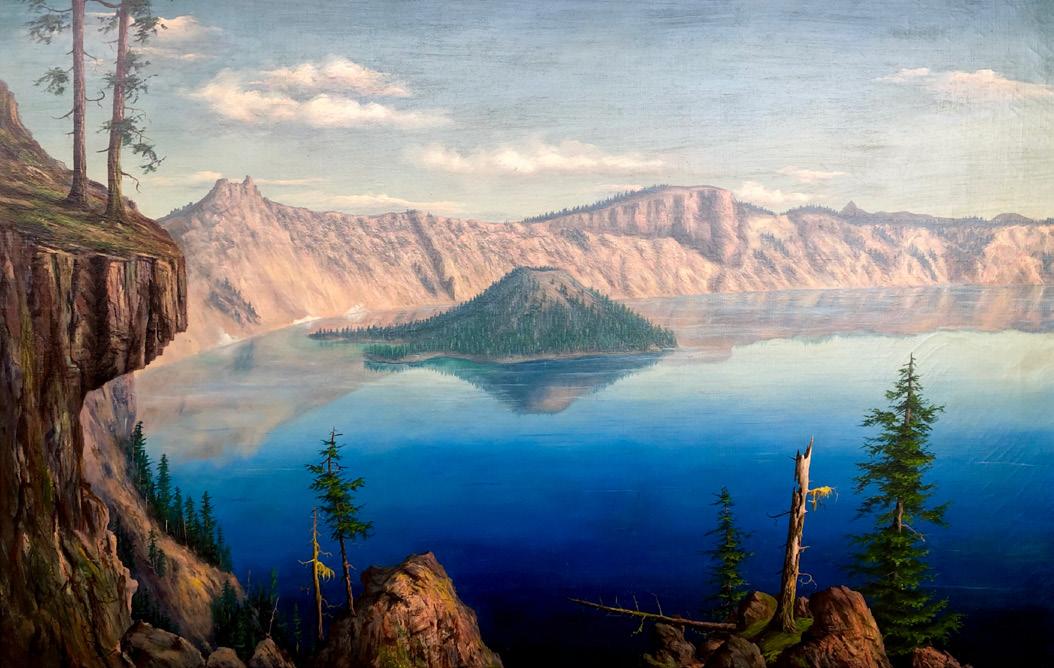
MARCH/APRIL 2023 15
Landscape Painters, continued
archival records do not record Stuart as a member of the organization until 1903 and then only for a year. Moreover, the extensive reports on and lists of those who participated in the 1901 outing make no mention of him. It is likely Stuart used the announcement of the Mazamas trip to Mt. Hood as an occasion to draw more newsy attention to himself and his gallery in Chicago.
Two other important landscape painters who played roles in the early years of the Mazamas, although neither seems to have become a member, were sisters Grace Russell Fountain (1858–1942) and Mabel Russell (1875–1959). Grace was born in Yreka, California, but grew up in Ashland, where Mabel was born. Their mother had artistic talent and worked as a gravestone carver. It is not entirely clear where the sisters received their initial lessons, but in the 1890s they became either friends (in the case of Grace) or acquaintances (in the case of Mabel) with William S. Parrott (1844–1915) when he maintained a studio in Klamath Falls. Parrott had been a member of the Oregon Alpine Club (1887–
from previous page
1893), which William Steel also founded, and which was the direct forerunner to the Mazamas. Parrott also painted many of the Cascade Mountain peaks and Crater Lake and was compared during his lifetime to the greatest artist of western scenes during that era, Albert Bierstadt. Grace lived with her husband, a businessman, in Klamath Falls at the time Parrott was there. Occasionally Mabel crossed the mountains from Ashland to visit. It is during these years that we know that both Fountain and Russell visited Crater Lake and both received lessons in painting from Parrott. Grace’s breakthrough into the ranks of the region’s top artists came while she was in Klamath Falls and when she made a significant sale in 1895 of one of her Crater Lake paintings. That was to Adolph Sutro, a millionaire and the then mayor of San Francisco. A newspaper reported that Sutro, who would “have nothing short of fine works of art in his gallery, saw Crater Lake once, and was quick to recognize the worth of the picture, which now occupies a place in his art gallery in the famous Cliff House.”

Above: While maintaining a studio in Klamath Falls in the 1890s, William S. Parrott, who had been a member of the Oregon Alpine Club, the forerunner to the Mazamas, came in contact with Grace Russell Fountain and her sister Mabel Russell. They took lessons from him, and during these years Fountain became regionally known for her paintings of Crater Lake. This view of Mt. Shasta is from the hand of Parrott during his time in Klamath Falls. Courtesy, Tucker-Krosby Collection.
In August 1896, Fountain and Russell joined the Mazama summer outing at Crater Lake. It was an especially bold affair. During these years, one of the primary goals of William Steel, president of the Mazamas in 1894 and 1895, was to obtain national park status for Crater Lake. He carefully planned the annual outing in 1896 and advertised it widely so as to attract, in addition to Mazamas, members of various civic, conservation, and Crater Lake clubs located in Southern Oregon. His hope in doing so was to bring additional awareness to Crater Lake. People and groups from the area answered the call, showing up in larger numbers for the outing than
16 MAZAMAS
did Mazamas. During one of the outing’s evening-time festivities where handselected participants offered addresses, provided readings, shared stories and poetry, performed sketches, and sang, Mabel Russell presented a recitation. It was also during this summer outing when the Mazamas christened the huge volcano in which Crater Lake sits as none other than “Mt. Mazama.” Fay Fuller from Tacoma was also on hand; she had the honor of smashing a bottle of Crater Lake’s water as part of that inauguration ceremony.
It is generally agreed that the 1896 outing helped drive forward Steel’s plan to preserve Crater Lake as a national park. But a somewhat overlooked factor in this was the art of Grace Fountain. In early 1902, as debates over Crater Lake’s fate were about to get underway in Washington, D.C., Joseph Silas Diller (1850–1928) secured a painting of Crater Lake from Fountain to display in Washington, D.C., for elected officials to view. Diller was a long-time member of the United States Geological Survey and an ardent supporter of national park status for Crater Lake. He had attended the 1896 Mazama outing and in the same year received an honorary
membership from the organization (Diller Glacier on Middle Sister was named for him). A Klamath Falls newspaper reported later in 1892, when Congress approved park status for Crater Lake, that “One of the factors of no small influence in the campaign for furthering passage of the Crater Lake national park bill through congress...has been a large and beautiful painting by Mrs. Grace R. Fountain, formerly of this city...”
By then Fountain and her family had moved to Portland where she operated her own studio, sometimes with the help of her sister Mabel. A few years later she left for California. Her artistic reputation continued to grow as the Southern Pacific Railroad, hoping to capitalize on tourist travel to Crater Lake, commissioned her for various paintings and illustrations of that geological and scenic wonder. In August of 1903, so as to fulfill one of these commissions, Fountain traveled to Crater Lake in the company of a small group that William Steel led. Among those also on the excursion were another five individuals who were at the time or soon would become members of the Mazamas. Those included Prince Lucien
Campbell, president of the University of Oregon. Actually a charter member of our organization, Campbell was one of those who reached the summit of Mt. Hood on July 19, 1894, to participate in our official founding.
Grace’s younger sister Mabel came into her own as an artist after the turn of the century. She and other advocates for conservation causes also used her work to further their efforts. In 1912, for example, Russell sent one of her finished canvases of Crater Lake back east to Oregon’s U.S. Representative Willis C. Hawley. He used it in Washington, D.C., to advocate for more funds for projects proposed at the park. During debates over the appropriation, Hawley displayed and directly referred to Russell’s painting; Congress ultimately approved $50,000 for the park. Russell also received considerable attention in 1921 for her 60-by-70-inch painting of a destructive forest fire that had recently raged at Crater
continued on next page

MARCH/APRIL 2023 17
Above: William S. Parrott, “Three Sisters.” Courtesy, Tucker-Krosby Collection.
Lake. The painting could be lit from behind and the Scenic Preservation Association of Jackson County and the United States Forest Service used it to educate people as to the dangers that fire posed to scenic wonders.
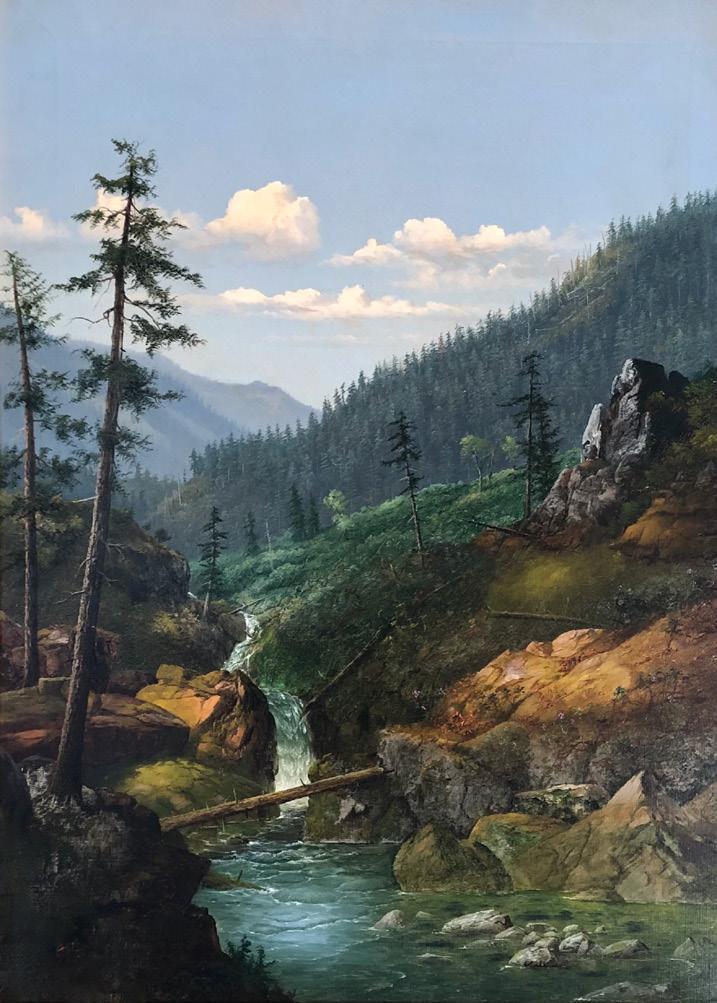
There is no evidence that either Fountain or Russell summited any of the Cascades’ major peaks. Neither was among those, including Fay Fuller, who scaled Mt. McLoughlin (then generally referred to as Mt. Pitt) during the Mazama 1896 summer outing to Crater Lake. Both Russell and Fountain, however, spent considerable time in the Cascade Range over the years. The former continued to live in Ashland for some time and regularly traveled to Crater Lake as well as to Mt. Shasta (she had a studio at its base for several years) where she worked and sold paintings to tourists. While she might not have climbed, Russell was sometimes exposed to the perilous conditions that mountains can afford. In early September 1912, for example, when temperatures dropped precipitously around the state as an unusually cold summer storm passed through, Russell was at Crater Lake. “Two feet of snow fell,” according to a news report of the fiasco, and Mabel and another sister who was with her “were unable to leave their tent for nine days.” Russell survived the snowfall and in considerably better condition than Stuart had survived his accident on Mt. Adams back in 1884.
Russell and Stuart both searched for their art in their studios and in the mountains. They were both, along with Fountain, Akins, and Parrott, the products and the purveyors of the cultural and nationalistic excitement that animated interest in the Cascades’ monolithic volcanic peaks and western landscapes in the latter half of the 19th century. That fascination with mountains also inspired the founding of the Mazamas in 1894. That the region’s landscape painters converged with and in our organization as both members and promoters of its mountaineering and conservation causes makes complete sense. The legacy to us from these artists is manifold. They helped breathe life into the early Mazamas, they helped push forward some of the organization’s early environmental activities, not the least of which is the preservation of Mt. Mazama in a national
park, and they created a stunning and colorful archive of the past that visually records and communicates another dimension of our story and the story of our mountains.
18 MAZAMAS
Above: William S. Parrott, “Mountain Stream” Courtesy, Tucker-Krosby Colleciton
Landscape Painters, continued from previous page
AN EVENING WITH GEORGE CUMMINGS IN HIS CERAMICS STUDIO
by Kate Evans and Alexandra Howard
Many of us, while isolated during COVID, did a lot of baking, gardening, reading, or starting a new hobby or project.
Long-time Mazama George Cummings revisited a previous passion in his life, ceramics, and returned to playing with clay. George was a prolific potter from 1966 to 1979, while teaching at the Museum Art School (which became the Pacific Northwest College of Art) and the late Arts and Crafts Society of Portland. His recent return to ceramics has resulted in new styles and forms when compared with his previous work. His current studio is rich with dynamic and textured handbuilt sculptures, with exuberant glazes, and features such as coiled tubes (#6 on p. 21) that demonstrate a deft understanding of clay.
We visited George’s studio in May 2022 to see what he had been working on. Captivated by his work, and with a hint about George’s life in and out of ceramics, we came back to learn more about what he was doing, how he works, and the path he took.
George’s previous ceramics life began in 1961 with an evening class at the Museum Art School in downtown Portland. George, who moved to Oregon in 1959 after graduating from the University of British Columbia in philosophy, was working in life sciences at the University of Oregon Medical School and sharing an apartment in Goose Hollow with fellow Mazama and architect, Bob Belcher. Bob suggested that they take an evening class in life drawing at the Museum Art School just half a mile away. George had been active in art all through grade and high schools but had put it aside when it came time to prepare for college, art being generally viewed as a nice avocation but not as a suitable career for someone bright enough for higher education. Bob promptly signed up for life drawing, but George delayed and was told the class was full. "What else do you have?" he asked. "We have ceramics," the registrar replied. "OK, I'll take that," said George. He signed up and began his career in ceramics.
At the Museum Art School, he studied pottery with Bennet Welsh, who owned Pacific Stoneware. One evening in late 1962, Bennet mentioned that he sometimes hired beginning potters to
continued on next page

MARCH/APRIL 2023 19
Above: George Cummings with 39" tower, clear glaze over colored slips, steel base, 2022. Photo by Alexandra Howard.
George Cummings, continued from previous page
work in his factory. Not very seriously, George asked, "Would you hire me?" and Bennet very seriously replied, "Yes, I would." Thus ended George's career in science. He quit his job at the medical school and began working at Pacific Stoneware making everything from kitchen wares to umbrella holders to completing random commissions. In 1964–1965, his position at Pacific Stoneware transitioned to working abroad in the studios of Bryan Newman in London, U.K., Philippe Lambercy in Geneva, Switzerland, and Lifas in FerneyVoltaire, France. He returned to Portland in 1966 and taught ceramics, as noted above, and gave summer workshops in British Columbia, Maine, and Oregon.
In 1979, George left his position at the Museum Art School. At that time, he considered becoming a studio potter and borrowed space from a friend to throw and initially fire about 60 of the thin-rimmed vases ("Cummings pots") he was known for. He found, however, that physical pain from being hunched sideways over a potter's wheel severely limited his productivity, and that the cost of setting up a studio was beyond his means. So he wrapped the vases in newspaper, packed them in boxes and looked for a job. George stopped making ceramics, and after another short stint at the medical school, he was hired by Standard Insurance where he worked in IT for nearly 15 years until retiring in 1996.
Sometime not long before COVID, George decided to open some of the boxes of vases he had thrown in 1979–1980. He was surprised to find four bowls suitable for “a whole-meal salad” that he wanted to use. He reached out to his former student, Pat Horsley, who has a pottery studio in southeast Portland (patrickhorsley.com), and asked him if he would glaze them. Pat did, and George asked if he would glaze some of the thin-rimmed vases too. Again Pat obliged, but instead of the restrained earthen tones characteristic of George's earlier vases (#4 on p. 21) he chose brilliant,
contrasting colors. At first taken aback by them, George soon changed his mind about the bright glazes.
typically spends about five hours every day in the studio. The intricate and engaging work we saw there is evidence of his rekindled passion. He credits Pat Horsley for supporting his return to ceramics. “Without him, I wouldn’t be playing with clay.”
The first things he made when he began to play with clay again were pinch pots. "I've made dozens of them. It's relaxing, and they are great for testing glazes and as small gifts" (#7 on p. 21). Paulus Berensohn's seminal work on pinch pots, Finding One's Way with Clay (1972), includes a full-page spread of three of George's pinch pots.
In the spring of 2020, inspired by these successful glazes and with time on his hands due to the cancellation of Mazama activities because of COVID, George got some clay from Horsley and started handbuilding pottery. Though each piece was a vessel, usually with a fluted opening that could be used to hold a weed or flower, his intention was sculptural rather than utilitarian. Again, Pat generously glazed and fired George’s new work. By summer, it was clear that George needed to get his own materials and a kiln.
Since that time, George has been refining his skill in handbuilding using pinch, coil, and slab techniques, or a combination of them, instead of throwing on a potter's wheel. He also began developing his own glaze palette by testing readily available published recipes. It has been two years of trial and error, experimentation, problem solving, and play, which still continues. George said he
George's current work is almost entirely sculptural but typically based on his background as a potter. Like pottery, it's all hollow, and there's often an opening at the top, but unlike most pottery, it's simply decorative rather than utilitarian. The early trumpet-like openings, for example, evolved into flowers, and then the flowers were arranged in bouquets with quite different bases (#1, #2, and #5 on p. 21). New ideas often emerge in this way with a successful idea becoming a theme, which George develops in a series of pieces until he has another idea.
His improvisational creativity can be seen in his series of "towers" up to 39 inches tall that consist of separate segments stacked on top of one another and either glaze fired together or glued with a strong epoxy after glaze firing. Some of the shorter towers are topped with small houses (#1 and #3 on p. 21) which friends said were whimsical and reminded them of Dr. Seuss. Whimsy is a feeling that typifies most of George's work. "Playing with clay is fun—well, not always—and I want people to enjoy what I make. Smiling and laughing when they see my work is a high compliment."
On one recent occasion, necessity was the source of creativity. George had been working on small, complex pieces that look like parts for something mechanical and take a day or more to finish (#6 on p.
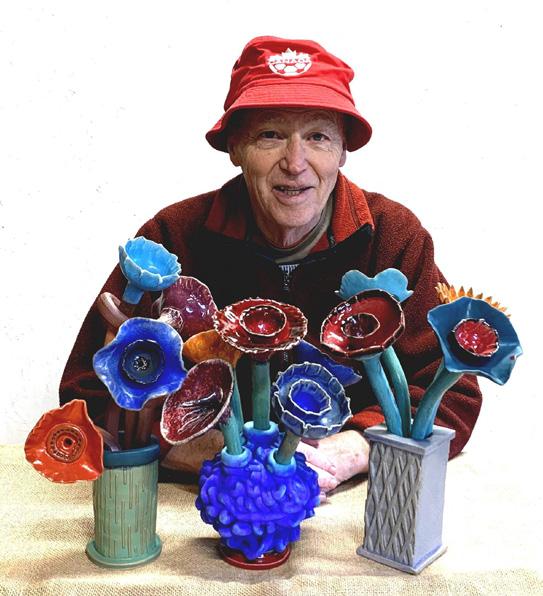
20 MAZAMAS
Above: George Cummings with three flower arrangements, colored glazes, 202. Photo by Huy Nguyen
Above
1. House with red-glazed roof, clear glaze over slip decoration, 2021, 12"
2. Flowerpot, colored glazes, Jan. 2022, 12.5"
3. House tower, clear glaze over colored slips, Feb. 2022, 14.5"
4. Thin-rimmed vase, colored glazes, late 1970s, 9"

21). At this rate, he realized it would take him months to fill his small (6 cubic foot) kiln. So he turned to rough slab building and in a week had ten pieces that filled the remaining two-thirds of the kiln (slab building is like carpentry with clay "boards" that can be roughly slapped together or carefully joined).
There are two series of slab work in marked contrast to the rough slabs and, in fact, to the rest of his work: a mechanical series just mentioned and one with an architectural feel (#8 above). Both are characterized by clean lines and sharp edges—no flowers. The former are like toys with round and rectangular tubes with mysterious functions, and just for the fun
5. Four-flower bouquet, clear glaze over colored slips, base with blue and red glazes, 2022, 8"
6. Slab construction with coiled tube, unglazed, 2022, 5.5"
7. Pinch pot with clear glaze over colored slips, 2022, 5"
8. Slab vessel with textured sides, black glazes, Sept. 2022, 8"
of it, you may be able to blow into the end of a tube and after several twists and turns have air come out the other end. There are also tubes you can see through. The architectural pieces are more serious with slab sides that are textured with a variety of rollers, the first of which was rebar. Now, George has a dozen rollers he made by cutting wood dowels on a table saw to make a simple pattern of parallel lines or a complex pattern of diamonds from a double helix. The rollers alone are works of art. George has also carved stamps out of insulating firebrick to provide another way of creating textures (windows in #1 and #3 above). These series with their clean lines
and sharp edges have a precision that is impressive.
Nearly a year ago, Pat Horsley gave George five pounds of white slip powder he wasn't going to use. Slip is just clay mixed with a little water. In this case, the clay is white and is used as the base for decorating with colors by adding metal oxides and ceramic stains to it. Cobalt oxide, for example, usually produces various shades of blue, depending on how much of it is added. George did nothing with the slip for several months before deciding to test it with red, orange, blue, green, and black colorants under a clear glaze on one of
continued on next page
MARCH/APRIL 2023 21
his little houses. The result surprised and delighted him, and when he showed it to Pat, his response was "Wow!" George now has a palette of a dozen colors and shades, which allow him to individualize the color of coils, textures, flowers, etc. instead of using a glaze of one color over everything. Slips have created a bright new world for George's ceramics (#3 on p. 21).
All over George’s studio there is evidence of active hands and a curious mind. There are tools used to create new shapes and patterns, dozens of glaze and slip tests, labeled containers of glazes, and arrangements of completed and in-process sculptures on most of the flat surfaces. While there are clear distinctions among the current series, they are united by visual complexity and color, and show continued refinement in his handbuilding techniques.
The new work looks radically different from his earlier work from the 1960s and 70s, which has a different aesthetic: the surfaces are matte, the colors darker and earthen, and the shapes often, but
not always, simpler (#4 on p. 21). The apparent differences led us to ask him how his approach to work changed over the decades. He said it hasn’t. He may begin working without a clear goal in mind, starting with a slab or coil and seeing what happens, seeing what isn't there but could be, playing with the clay, asking "What if?" until something new emerges—or doesn’t. Or he may start with an idea or rework an old theme or have a specific need or decide that it’s time to recycle the clay and start over. But no matter how he proceeds, there’s always room for the unexpected, for going off in a different direction. Unlike a production potter, making sets of identical pieces, everything George makes is unique.
George has enrolled in a wheelthrowing class this fall at PCC Southeast Campus to see if he can still throw after a hiatus of 42 years and to extend his handbuilding by making units that can be assembled into something bigger.

When talking to George, we were often reminded that he has been an inspiring
teacher for much of his adult life, teaching ceramics at the art schools and workshops, and mountain climbing at Reed College and the Mazamas. He ever so patiently answered our many questions about gas and electric kilns, glazes, slips, tools to create special effects, his old versus his new work, the ways he works, and so on.
As we were finishing our tour of his studio and heading upstairs for a snack and some refreshing lime water, he held up an old vase, which he said would have been more interesting if a contrasting glaze had been used on the inside. While it was beautiful to our eyes as it was, George’s statement and expression perfectly captured the feelings of openness, playfulness, and curiosity that seem to emanate from him. It was a wonderful summer evening in the studio with George.
George’s current work is available for viewing and purchase. If you are interested in either, you may contact him at gcmmings@gmail.com.
22 MAZAMAS
Above: George Cummings with 19.5" tower, clear glaze over colored slips, 2022.
George Cummings, continued from previous page
Photo by Alexandra Howard.
SUCCESSFUL CLIMBERS
Due to ongoing negotiations with the United States Forest Service, we've recently been unable to publish the lists of successful climbers. The list below details only successful climbs in the areas where the Mazamas are currently allowed to operate.

MAZAMA CLASSICS
We lead a wide variety of year-round activities including hikes, picnics, and cultural excursions. Share years of happy Mazama memories with our group. All ages are welcome to join the fun.
■ The Classics Committee needs an infusion of new members. We are down to five people. Members are in short supply to offer classics events. Please email Flora at flobell17@comcast.net to apply. We meet via Zoom on odd-numbered months.
■ Upcoming Classics hikes
□ HK A1 Mar. 8. Cascade Locks to Eagle Creek and back. Leader: Flora Huber, 503-816-5713. 4.5 miles, 300 feet elevation gain. Eat lunch in Cascade Locks after the hike. Meet at Lewis and Clark State Park, 9 a.m.
□ HK A1 Mar. 15. Herman Creek Pinnacles. Leader: Flora Huber, 503-816-5713. 6 miles, 950 feet elevation gain. Meet at Lewis and Clark State Park, 9 a.m.
□ HK A1 Mar. 23. Catherine Creek. Leader: Flora Huber, 503816-5713. 3.4 miles, 600 feet elevation gain. Meet at Lewis and Clark State Park, 9 a.m. Many wildflowers.
□ HK A1 Mar. 28 Devils Rest from Larch Mountain Road. Leader: Flora Huber, 503-816-5713. 5 miles, 500 feet elevation gain. Meet at Lewis and Clark State Park, 9 a.m.
CONTACTING THE CLASSICS
Contact the Classics Chair, Flora Huber, at 503658-5710, flobell17@comcast.net, or classics@mazamas.org.
SUPPORT THE CLASSICS
The Classics Committee needs a volunteer to put more content in our column on a quarterly basis. We want to document past Classics events and make sure that our postings to the web are current and complete. More generally, there is always work to be done on the committee. Our meetings are the fourth Monday of every other month at 11 a.m. on Zoom. Email classics@ mazamas.org and tell us how you can help.
CLASSICS COMMITTEE MEETING
Keep an eye on the Mazama calendar for our next meeting.
MARCH/APRIL 2023 23
For members with 25 years of membership, or for those who prefer to travel at a more leisurely pace.
January 1, 2023–Mt. Hood, South Side. Pushkar Dixit, Leader; Shiva Kiran, Assistant Leader. Aardra Athalye, Rob Sinnott
Above: ICS students at Horsethief Butte during rock weekend, September, 2022. Photo by Heidi Griffth.
THE ALANO CLUB OF PORTLAND & THE MAZAMAS
 by Claire Tenscher
by Claire Tenscher
Peak Recovery, a new outdoor movement-based project sponsored by the Alano Club of Portland, has partnered with the Mazamas to offer a free nine-person "Mazama + Peak Recovery" BCEP team for people in recovery from mental health and/or substance use struggles. Peak Recovery offers free multi-day and multi-week courses in mountaineering, splitboarding, and rock climbing. Their mission is to use outdoor activities to inspire and empower people in recovery to build confidence, resilience, and recovery capital—literally allowing them to reach new heights!

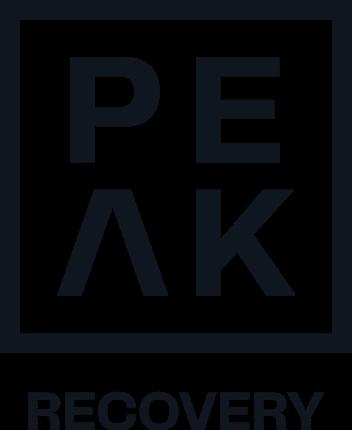

The group’s founders, Brent Canode and Ali Marie Koch, experienced the healing power of mountains firsthand through their own recovery, and they created Peak Recovery to share these therapeutic outdoor experiences with others in recovery, free of cost. There is often a high barrier to entry for those who are new to the outdoors, so Peak Recovery/ The Alano Club funds the cost of training and provides transportation to all its courses.
The Alano Club of Portland is the oldest and largest recovery center of its kind in the nation, with a 79-year history of supporting individuals in or seeking recovery. Like the Mazamas, the Alano Club owns a beautiful property in Northwest Portland out of which they operate. They have over 10,000 visitors a month, a long history of successful fundraising, and experience working with corporate partners. The Alano Club has won multiple national awards for their innovative programs including The Recovery Gym, which offers free CrossFit classes and trail running programs for people in recovery.
The Mazama board saw a great opportunity to work with another Portland legacy organization that has changed thousands of lives. It also helps the Mazamas get in front of another audience in the area, and we can benefit from their strengths as we continue to work together into the future.
24 MAZAMAS
BOOK REVIEW
THE ART OF SHRALPINISM
by Ali Gray
Part memoir, part guidebook, part coffee table book, The Art of Shralpinism is an insightful read for anyone who enjoys being in the mountains. While written directly for snowboarders (Jeremy Jones himself is a pioneer and luminary in the snowboarding space), skiers, climbers, and even armchair alpinists can learn from and be inspired by the stories, wisdom, and pieces of artwork Jones provides his readers.
The Art of Shralpinism is a beautifullydesigned and tactile book, and I recommend picking up a physical copy rather than the ebook or audiobook. It invites you to flip through and catch snippets of knowledge or inspiration from the extras interspersed throughout the pages—quotes by key figures in the industry, Jones's heart-stopping anecdotes and beautiful watercolors, and sidebar pieces of guidance—without having to spend more than a few minutes or dive into the bulk of the content.

For those who do read it cover to cover, Jones guides you loosely through the story of his life by way of the book's three parts: wisdom, science, and art. "Wisdom" starts with Jones's early experiences as a New England kid so obsessed with the sport that he was the first snowboarder allowed to ride Stowe in 1986. He discusses wearing out both his body and mind on the snowboard pro race circuit—and later on huge mountains with a helicopter—at an early age.
The realization that he'd taken the sport as far as he could while staying alive and well made Jones accept that it was “…time to give these mountains the respect they deserved. Time to sleep under these dream lines, to learn from them and live with them. Then when the time became right, to tiptoe up them and snowboard back down.” In other words, it was time to transition to human-powered riding, and eventually become the backcountry aficionado, business owner, and environmental advocate he is today.
The ideas of risk, ego, humility, and mental health weigh heavily in the opening third of the book (and throughout), which
is refreshing in contrast with much of the mountain adventure literature of the past. Jones provides so many takeaways: that the journey is the reward; that goals are great but to not live your life by them; to leave your ego at the trailhead; to share your mistakes; to find good partners and mentors; to be present, have patience, and just say no; that riding the lifts at the resort can be just as fulfilling as risking your life for a few powder turns on a high avalanche day; and many more.
He also discusses fear, and the difference between good and bad fear. While good fear (of objective danger, for example) can keep you alive, I do wish he spent more time talking about overcoming bad fear—the kind that keeps you from even trying to achieve your goals. Jones mentions that he suffers more from overamp and too much gusto, which I guess is why he has snowboarded astounding lines around the world while I sit in my chair sweating while reading some of his anecdotes about being in tricky situations.
"Science" dives into the more concrete knowledge Jones has gained over the years. He goes over topics like terrain progression, whether or not to climb a couloir you want to ski, how to pick a descent line, and cornice safety. While I still enjoyed it, I thought this section was less compelling than the rest of the book.
The intended audience is a bit unclear (such as the introductory-level avalanche and winter camping information paired next to sidebars about going big in the big mountains), and many of his points could be better illustrated with real photos rather than the (albeit nice) drawings that are used.
Nevertheless, I enjoyed his discussions of injuries (focus on what you can do, not on what you can't), nutrition (Jones is a "cheating vegan" in part because he's found it reduces crummy feelings in the mountains), and fitness (like me, Jones is "allergic to the gym"). The section on riding with an axe was also interesting, and the corresponding anecdote gripping. While it sounds easier for snowboarders to use an axe while riding than for skiers, as a skier I hadn’t thought about 50+ degree heel edge turns being the hard ones, with less leverage to arrest a fall—scary!
In "art" Jones describes how creating art is “getting on the other side of your brain and letting it take you for a ride,” and that the quality of what you create is
continued on next page
MARCH/APRIL 2023 25
Book Review, continued from previous page
irrelevant. The Art of Shralpinism is chock full of Jones’s artwork—even some poetry— and is an exploration of how combining your experience (wisdom) and technique (science) allows your sport to become art.
The final third of the book also delves into how transitioning to foot-powered backcountry riding rekindled his spark and love of the sport, and about the art of raising kids to be individuals rather than forcing them into the things he loves. Even as someone without kids, I could feel his joy that his son and daughter have each found their own paths to success in the mountains.
Jones's love for the mountains and the joy of being in them shines throughout The Art of Shralpinism. So does his respect for and understanding of the risks of adventuring in the mountains, and that doing so is a privilege. While the book fell a bit short on the need to diversify the ski industry, I greatly appreciated that Jones does at least include a few outside voices about the cost barrier, lack of representation, and the idea of skiing being a somewhat extractive industry from an indigenous point of view.

I also appreciated his call to the outdoor community to act around climate change and its effects on our sport— increasing snowpack instability due to erratic and extreme weather, rain or the lack of snow in midwinter, and the idea of "last descents," to name a few. As the founder of Protect our Winters, Jones is very active in the fight against climate change using large-scale policy issues.
The Art of Shralpinism. is a love letter to the mountains, and I recommend it to anyone who appreciates the joy of being in a snowy winter wonderland. The mountains are a blank canvas, inviting us to create something beautiful.
26 MAZAMAS
Above: ICS students at Smith Rock during multi-pitch weekend, October 23, 2022. Photo by James Jula.
MAZAMA ARTISTS
ALI GRAY
I’m a web designer by trade, but I enjoy graphic design and dabbling in ink and watercolor in my free time (if I’m not out exploring in the mountains or playing with my cat). Over the years, I’ve designed a handful of topsheet graphics for a custom ski manufacturer in Wyoming, which is a true dream come true. I own skis with one of my designs, and could hardly bring myself to ski on them—now they’re pretty wall art! I’ve never thought of myself as being any good at art away from the computer, but a few years ago discovered working with ink and am loving it, and slowly improving. Not having an undo button is stressful! More of my work is on my website, iamalidesign.com.




MARCH/APRIL 2023 27
Clockwise from top: "Meadowlark," ink; skies "Mountain Trout;" "Mountain," ink; "Gray Heron," ink.
KOKO OLSZEWSKI
Koko Olszewski has long held a passion for art, education, and community building. A social practice art facilitator at heart, she is interested in the ways we can use art to connect and strengthen community, as a tool of inquiry to question existing social systems, and as an experiment in understanding who we are, where we are, and everything we’ve touched to get to this very point. Born and raised in Baltimore, Maryland, she studied at St. Mary’s College of Maryland and got her Masters in Teaching K-12 Visual Art. After graduating, Koko moved to the west coast to complete two years of service with Habitat for Humanity as an AmeriCorps Construction Crew Leader. With AmeriCorps, she planned and implemented the Vancouver Women Build first Recycled Arts Festival in the Habitat Store parking lot. During her time at Habitat, she facilitated two murals, one at the Habitat Store in Vancouver, WA, and the other as Beaverton’s first intersection mural in the Vose neighborhood. In addition to social practice arts, she’s always been interested in using the accessible resources that already exist in her environment to create something new while doing what she can to reduce waste. While working at Habitat she began to take home discarded scrap materials to utilize as canvases (t1-11 siding, vinyl flooring, broken pallets, and subflooring, for example). It was from this resourcing that this series entitled “Deep Persistent Layers” was born. She deeply enjoys rebuilding mountains that she’s spent time climbing and getting to know more intimately. She sees and loves the parallels in mountaineering and art as tools to learn more about who we are and see into brand new corners of ourselves and the world.
Above


28 MAZAMAS
: "Colchuck Lake," clay and acrylic on reclaimed wood.
Below: "Goat Rocks Wilderness," clay and acrylic on reclaimed flooring.
Above left: Custom rolling gate, private collection. Above right: "Mountain."
Below left: Untitled.
Jill Torberson is an artist, principal, and owner of Weld Metal Works, a design/build steel fabrication studio in Portland, Oregon. Jill is a licensed and bonded contractor, a certified welder, and has been registered with the Oregon Construction Contractor’s Board since 2013.

Weld Metal Works specializes in designing, fabricating, and installing site-specific artworks. The collection of work includes both functional steelwork and decorative art. Her work is included in many private residences, public places, and a museum collection in Oregon.

Jill’s design approach centers around the theme of “lightness.” She utilizes the structural integrity of the steel to create artworks that seemingly float, feel light, and may evoke fragility. Balance, mathematics, and minimalism are central to the work. She also considers both the daytime and nighttime conditions of place— whether through sunlight or ambient light conditions.
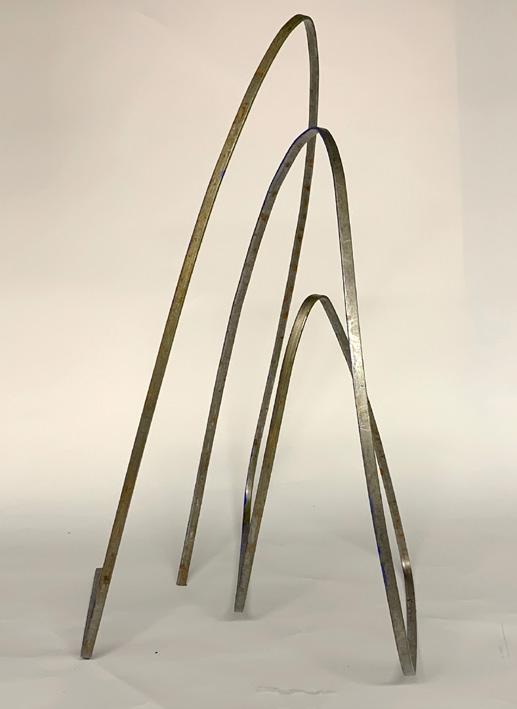
MARCH/APRIL 2023 29
JILL TORBERSON
ALICE BROCOUM
Alice Brocoum has taken art classes all her life (her father was her first art teacher). Now, as a retired science teacher with plenty of time and no one but herself to please, she's become more spontaneous and really enjoys the process in addition to the finished creations. Alice says that all her work is "inspired by the beautiful places I have been hiking. The particular view only gets chosen if it has an interesting composition and color palette. The medium: pastel (soft lines for animals and flowers), acrylic (freer, less controlled approach), or watercolor (more detail and gentler colors) varies by subject. In any case, I find that a painting is always more expressive than a photograph. The time spent observing when painting helps me remember that particular scene better."
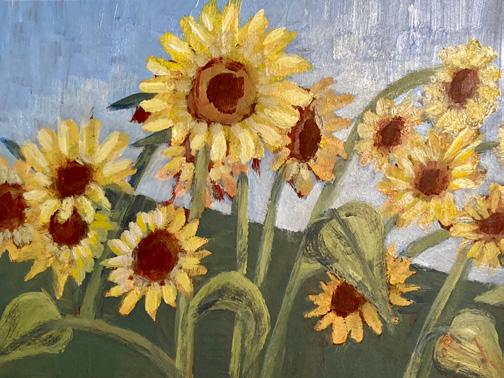
Top right: "Stream Crossing," acrylic. Right middle: "Balsam Roots," acrylic. Bottome: "Gorge View," watercolor.


30 MAZAMAS
SARAH LYDECKER
Sarah has worked as a set designer and scenic painter at over a dozen Portland theatres, as well as for Portland-filmed TV shows such as Grimm, specializing in mural painting, faux finishing, blood effects, and gore. In her own pieces, Sarah only paints places she has visited; her images come from a sense of joy and deep respect for these landscapes, aiming to combine the right palette of colors to capture their emotional depth.
Rock climbing became Sarah's passion after taking BCEP in 2014, and she’s worked to advance her trad leading skills in preparation for longer alpine routes; this past year she led the crux pitches of the classic North Ridge of Mt. Stuart and Outer Space in Leavenworth. She has also assisted with BCEP, various skill-builders, and Advanced Rock, and worked as the Climbing Coordinator for the Mazamas AdventureWILD program for kids. This year she will be leading instruction for the Introduction to Rock Climbing Program from Peak Recovery, which offers free outdoor programs for people in mental health and substance use recovery.
You can see more of Sarah's work at sarahlydeckerart.com, on Instagram, or by visiting her at the First Thursday art market in the Pearl.
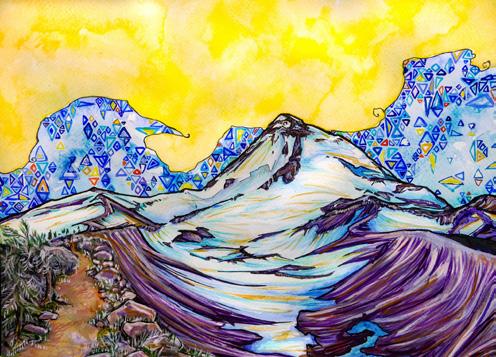
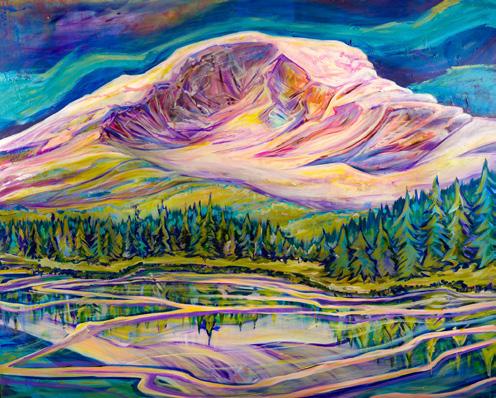
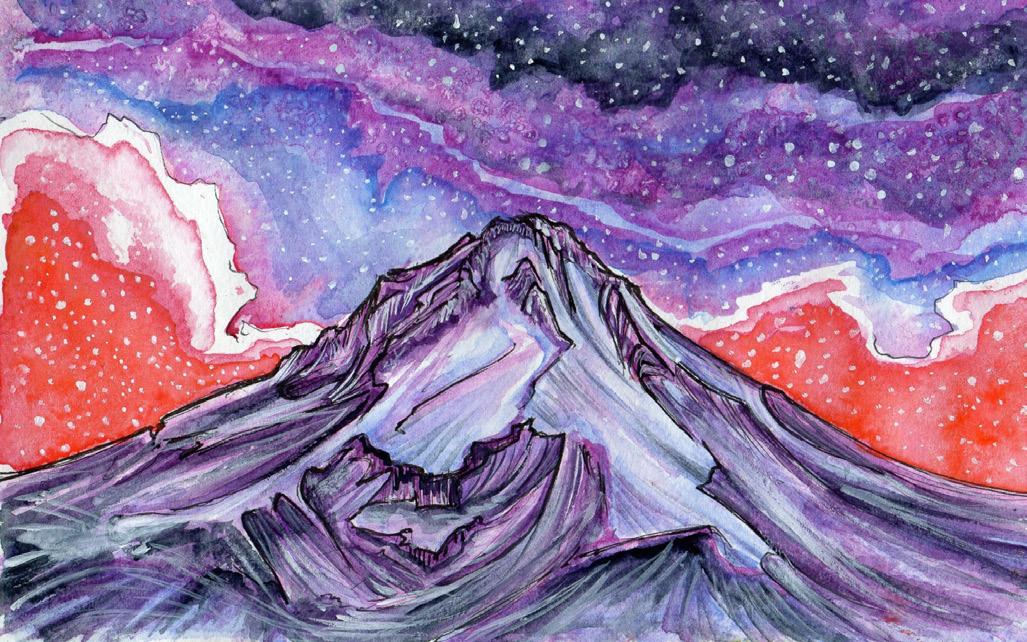
MARCH/APRIL 2023 31
Above: "Mt. Hood."
Left: "Mt. Rainier Reflection."
Below left: "Mt. Hood Starry Night."
BONNIE PAISLEY SCOTT
I learned to draw and paint from life before I ever climbed anything. From a very young age, I developed my stamina for “slow looking” by practicing drawing. I developed my eye for seeing color and feeling how colors are related to each other by using paint. I spent concentrated time looking at things that were in front of me. Sometimes, I would cast my eyes in the distance, but more often I would be looking at something up close. This practice has been with me for many years, I now teach it to others, and try to return to it as often as I can, especially during times when I need to settle my mind and body down.
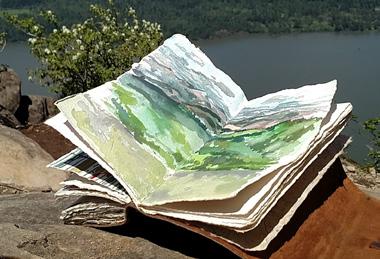


Since taking the Mazama Basic School in 2006, I have hiked (and climbed) up ten or so mountains in the Northwest, one in Africa, a high pass in Peru, sat on rocky beaches in Alaska and most recently completed a loop in Kings Canyon National Park. Sometimes, I am trailing behind my partner Greg Scott, or enjoying a more leisurely trip with friends or family. Forgoing all efforts to make my pack “ultra-light,” my sketchbook and a few materials often come with me.

32 MAZAMAS
Top: "Kings Canyon," drawing.
Middle right: "Angels Rest."
Middle left: "Kilimanjaro."
Bottom: Sketchbook.
STEPHANIE BUER
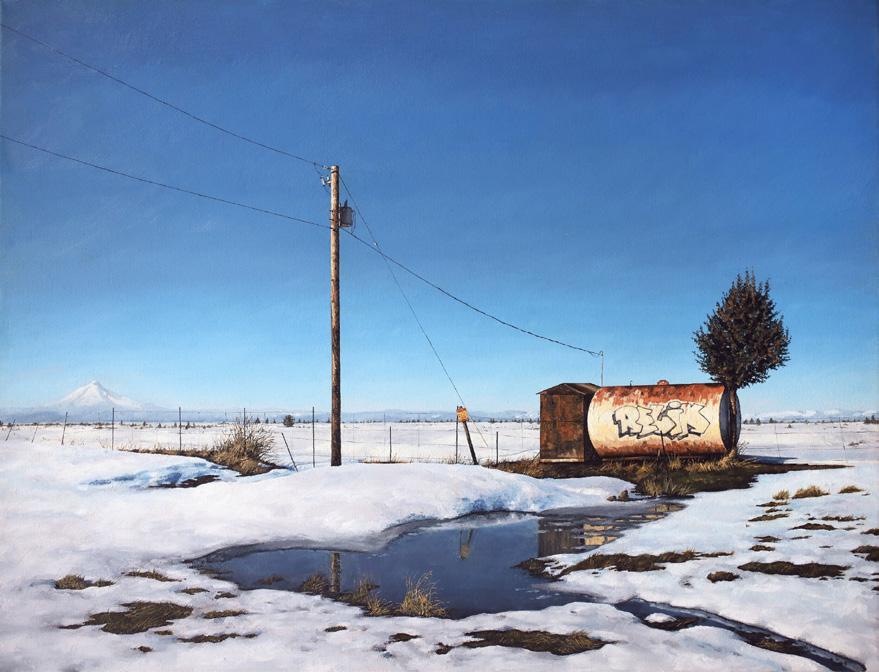
Stephanie took BCEP in 2012, not long after moving to Portland, and within a few years had taken ICS and Advanced Rock as well. She’s since volunteered to teach all of them, and has served on the ICS Committee, assisted Intro to Alpine Climbing, and taken Mountain Education Alliance training. She’s an avid rock and alpine climber with many summits under her belt, including the North Ridge of Mt. Baker, Mt. Rainier’s Kautz Glacier, Mt. Stuart’s West Ridge, and several in British Columbia's Bugaboos and Idaho’s Pioneer mountains.
Despite her love of climbing, Stephanie’s art has focused mostly on urban landscapes, which she first explored during a decade in Detroit. Combining exacting detail with a painter’s eye for light and composition, her charcoals and paintings are portraits of unsentimental landscapes: freeway interchanges, desolate backstreets, crumbling factories being reclaimed by graffiti artists and nature. But she also sketches while hiking and climbing, and has considered running a plein air painting and drawing class.

Stephanie’s work can be seen at stephaniebuer.com, on Instagram, and at many galleries, including Talon in NE Portland.
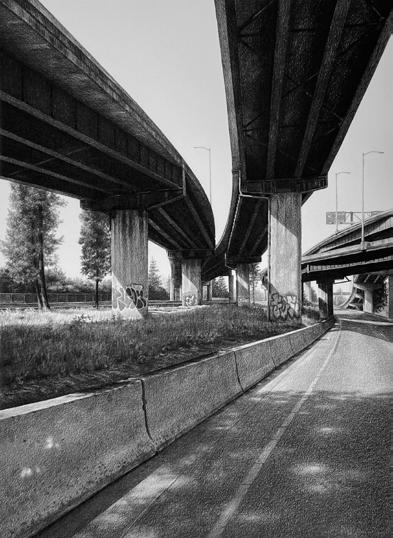
MARCH/APRIL 2023 33
Top: "Interstate 5 North," charcoal. Right: "St. Johns Bridge, charcoal. Below: "Recik", oil."
SURFING IN NARNIA
MAGICAL WINTER ADVENTURES WITH MAZAMA NORDIC
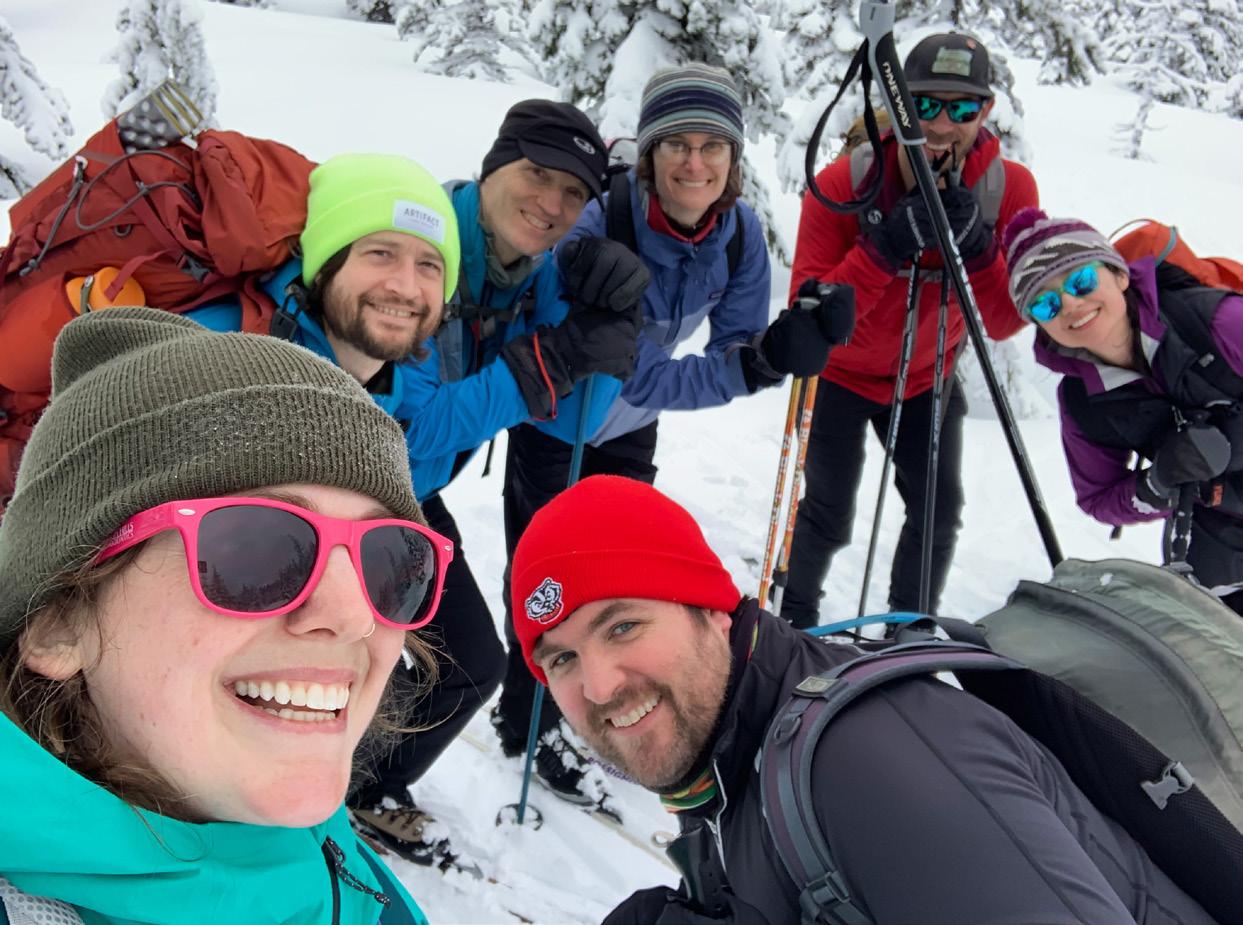 by Elise Englert
by Elise Englert
As a child, my only two references for understanding the world of skiing were 90s comedy movie sensation Dumb and Dumber, and a traumatizing story of my dad’s first go with skiing: He bombed down a hill, tumbled tail over tea kettle for a couple hundred yards, and dislocated his shoulder. Based on these cumulative cautionary tales, I perceived skiing as a death trap for the elite and avoided it successfully until I hit my early 20s. As part of a college outdoor club outing, I touched skis to snow for the first time and felt an immediate affinity for the sport. I got barely any snow in my undies, and left excited to try again! On that day a lifelong passion sparked within me: a passion for going cross-country skiing once every two years, introducing an overly-confident boyfriend to the sport, and watching him suffer and have a terrible time while I slid around easily like a roller-skating queen.
With ten years of boyfriend torture under my belt, as well as a long expedition to Badger Pass on which I managed to not die, I signed up for the Mazama Nordic Ski course in December. I felt motivated
to meet other skiers, start skiing more than bi-annually, and learn the words to describe the hodgepodge of self-taught survival techniques I’d cobbled together over the years. Also, I have seen people
do the thing where they carry skis while climbing UP a mountain and then ski DOWN a mountain, and in my mind, that is apex outdoor chaos, the type of thing you do to both impress and alienate all your
34 MAZAMAS
friends when you blow up Instagram with some Jimmy Chin madness. Anything I can do to get closer to that is a worthwhile educational opportunity in my opinion! I wasn’t sure which course to sign up for, but applied for the intermediate course because they would be going on trips over five miles (yay! I want to do that), required that you don’t fall much (I don’t, usually!) and also required that you had mastered a series of moves I had never heard of before (well, two out of three isn’t bad!).
At our orientation on January 4, we learned about the partnership between the Mazamas and Oregon Nordic Club (ONC) and watched an inspiring short video of ONC skiers on an expedition in Norway being absolutely throttled by hurricaneforce winds in open tundra. We learned that the Mazamas offers Incident Response Debriefings through the Critical Incident
Stress Management team, and that out of the few evacuations required by Mazamas since the CISM team formed in 1992, two have involved cross-country skiers. At that point, I wondered if I should pretend to go use the bathroom and quietly retreat to the (minimal) safety of my FIAT, but I stuck around to meet my crew: our teachers Tom Kline and Benjamin Dair Rothfuss, and six other students who I feared would leave me in the dust with their previous Mazama Nordic courses and no-doubt hearty knee ligaments.
Our first outing on January 22 started at 4 a.m.—for me at least, as I woke up an hour before my alarm from an excitement/ stress combo. I begrudgingly packed my rental skis into the car, scraped the ice off the windows, and thought grumpily about how nice warmth and sleeping are. I
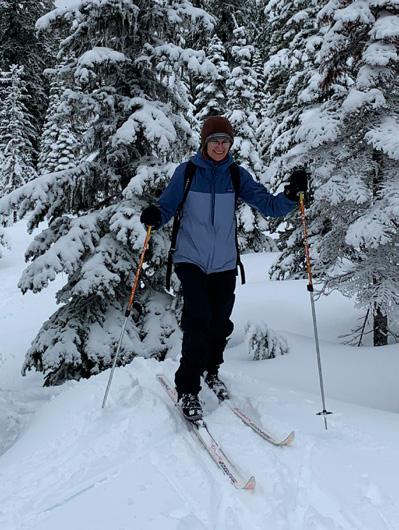
tracked down my carpool at the MMC and we were gas station burrito (and skiing!) bound. Our lessons at Teacup Nordic started with stretching, a quick drill, and a glide down to the meadow, followed by some individual attention on our poling and striding techniques. We learned to step firmly up steep hills so that our scales would get better traction. I learned my rental poles were too short AND I was holding them wrong. I had always avoided the black diamond sections of Teacup, but
continued on next page
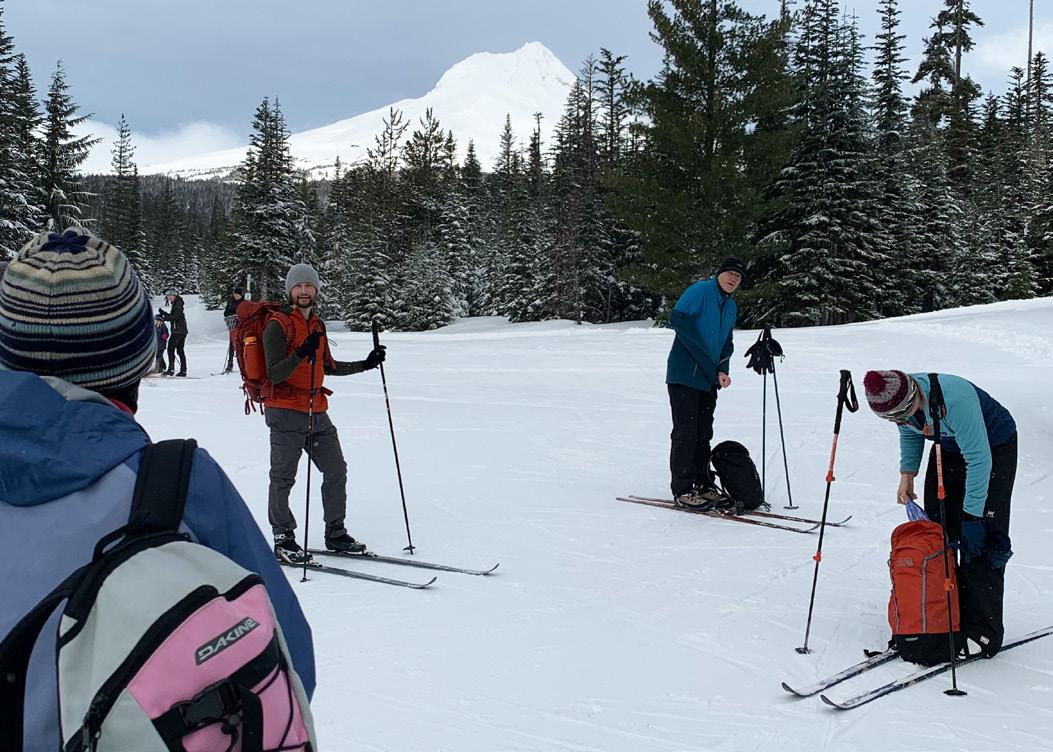
MARCH/APRIL 2023 35
Facing page: Author and team selfie.
Above: Intermediate Nordic class prepares for the day at the Nordic Junction at Teacup.
Right: Classmate Jessica Roberts happily navigates through the perfect snow in “the clearcut.”
Narnia, continued from previous page
this time with the safety of a group, no hills were off-limits! We attempted step turns, and various types of plow stops to slow ourselves. We took our first attempts at skiing off the groomed trails and I faceplanted multiple times. The snow was perfect, the sun was shining, and after hours of learning and playing, we finally headed home.
The next outing on January 28, there were no stress dreams, and no curmudgeonly disdain from this kid as I packed up my car in the morning rain to meet my carpool, just excitement. This time we met at Snow Bunny Sno-Park and practiced single-leg drills and doublepoling before heading off into the woods. We took turns breaking trail, and after a mile of stomping around with two inches of snow clogging my skis, I learned about Maxiglide wax and what an absolute miracle it is. This was a day of firsts after firsts for me: first time on a ski outing on ungroomed trails, first time attempting kick-turns, first time falling 10+ times in
one day. We navigated off-trail to a series of pristine meadows and hills of varying intensity until we finally made it to an area Tom called “the clearcut.” The name hadn’t made it explicitly clear to those of us participating in the search that the clearcut was going to be the most beautiful scene we’d ever seen: an array of snow-frosted evergreens so perfect, it looked like Queen Frostine (yes from Candyland) herself had arrived before us. As I glided through untouched, open lines of snow nestled between old-growth forest, I occasionally caught sight of my fellow classmates to either side of me. It felt playful, joyful, and magical, like catching a wave for the first time surfing, but in Narnia, and surrounded by friends. This moment was one of exquisite freedom, and knowledge that new doors had been opened up to me. Eventually, we reconnected with the trail system and made our way back to Snow Bunny Sno-Park, where the fluffy pristine hills that had been glowing in the sunrise that morning had been compacted to
ice slicks by hoards of children and their families having the time of their lives. It was back to reality, but now with a few extra tools for the next snowy wonderland adventure—I can’t wait to get out there again to chase that mountain high! Thanks, Mazama Nordic for a great experience!

36 MAZAMAS
Above: The class navigates the Vista Ridge trail at Teacup Nordic. Photo by Elise Englert
Author bio: Elise Englert is an Art Director and purportedly intermediate skier based in Portland, Oregon. She’s an outdoor (and indoor!) enthusiast and makes a mean broccoli cheese soup.
BOARD OF DIRECTORS MINUTES
by Claire Tenscher, Secretary
NOVEMBER 16, 2022
Attending: Greg Scott (in-person), President; David Urbaniak (remote), Vice President; Terry Donahe (remote), Treasurer; Claire Tenscher (remote), Secretary; Bob Breivogel (remote), Marty Hanson (in-person), Charles Barker (in-person), Aimee Filimoehala (remote); Staff: Kaleen Deatherage, Interim Executive Director (in-person).
WELCOME & CALL TO ORDER
The meeting was called to order at 6:37 p.m. by President Greg Scott. A quorum was present.
BUSINESS AGENDA
Policy ProPosals
■ Are we satisfied with the existing Finance Policy?
■ Membership Policy: Working draft shared. Current Bylaws state: all membership details, pricing, eligibility are in the bylaws. Proposed Bylaws will not have these details and they should be captured in policy.
■ Committee Policy: will be shared November 23. It contains a description and explanation of powers of each committee. There are three categories: board committees (board members only), board and member committees, programmatic committees (climbing and adventure). Some can spend money, some recommend, some can act on their own, this must all be captured in the policies.
■ A great deal of wording was taken from current bylaws.
■ Action requested: Input from directors. Time is crucial. Comments back by November 30.
EXECUTIVE DIRECTOR’S REPORT
■ We have Bylaws town hall meetings scheduled. Idea is to have these around the Portland Metro area. They will be on the calendar.
■ We are working to define the operational processes of the lodge with the staff we have today. Priority is serving our members, classes, and activities. Then we will focus on how we can generate revenue and serve nonmembers.
■ Brendan has gone through Salesforce to identify all donors from this year. Kaleen will send thank yous to all donors.
■ Bulletin deadline is approximately December 9.
■ We have a ton of interest in the program committee lately.
■ We have 2,210 member renewals. We had 2,790 last year this time.
■ Bob notes that programs will be great to resume, and it would be great to offer hybrid programs.
NW OUTWARD BOUND
■ Mazama Wild is on hold. NW Outward Bound asked if we would be open to letting them use the MMC for their summer camp program. We would make revenue from renting space without any need to advertise.
■ Board aligned to Kaleen meeting with them and getting details.
■ Kaleen departed at 7 p.m.
ALANO CLUB OF PORTLAND—PEAK RECOVERY
■ Sara Lydecker, Ali Koch (Project Manager, Peak Recovery), Joe Preston, Brent Canode (Executive Director)
■ The Alano Club is the largest substance recovery program in the country, it is 79 years old. The Portland club is unaffiliated with a national group. A house was left to the Portland chapter. The Portland group launched a recovery toolkit eight years ago—different methods for one to stay sober. Brent publishes research on recovery. From this research only 30 percent of 12-step participants were there a year later. They developed alternative methods of connection for folks that the meeting room isn’t the best fit. Many projects under the Alano Club of Portland for different folks.They do significant work with donors, brands, and the government. They’ve just received 18 months funding for an outdoorsbased mental and substance recovery program which is planned to include mountaineering, splitboarding, and rock climbing components. The intent is to inspire and build paths for recovery. The team wants to create an outdoors-based recovery community and make outdoor activity accessible to those in recovery, including skills and funding.
■ The request is to hold space for nine participants from Alano in this year’s cohort in BCEP in one dedicated group. Leaders do not need to be in recovery. Alano would cover per-student cost, Mazama membership, and annual program fee. They have an adventure van. They see potential for partnership. If needed, Alano could cover gear costs for their participants.
■ We have had recovery groups in the past. This year there are two leaders who have expressed interest in substance-free groups.
■ Board aligned with investigating how to make this work.
VACANT DIRECTOR SEAT
■ The council discussed adding Chris Jaworski to the council, and it was decided we would vote on it by email.
■ Terry asks if there are other past board or foundation members who could also serve.
■ Bob says we’ve asked people in the past with limited result.
GLACIATED PEAK LIST
■ Request from Marty to remove mountains from the list which no longer have glaciers. Decision made to potentially revisit in the spring.
AREAS OF FOCUS
■ Hiring ED: We need to meet and create a tasklist for this process. Need: ED job description, who should be on the hiring committee/leveraging past experience from the hiring committee.
■ Budget: David and Terry to connect on budget.
■ Lodge: Going to open for day use over Christmas break. Volunteer run.
■ Develop revenue: Terry, David, and Claire to connect.
■ Communication: Nothing to report.
■ Nominating: Charles and Claire. Largely on hold until bylaws update.
■ Access: f we don’t charge for climbs or hikes, we won’t be under scrutiny. The Mountaineers offer the programming to members for free, non-members get two free hikes or climbs a year. The recommendation will likely be to remove climb/hike fees.
MARCH/APRIL 2023 37
BOARD OF DIRECTORS MINUTES
COMMITTEE REPORTS
Accountant is 45 days behind.
VOTE BY EMAIL
■ Aimee Filmoehala approved as a board member.
CONSERVATION COMMITTEE REQUEST
■ The Conservation Committee has requested that we give an official position on Senator Blumenhauer’s Mt. Hood Bill. The Mazama Conservation Committee has significant concerns regarding this proposal because it does not do enough to promote additions to Wilderness, and we recommend we oppose it as presently drafted. We instead recommend that we adopt the position of improving it as has been officially documented by Oregon Wild, which can be read in full here: oregonwild.org/about/blog/why-wereopposing-rep-blumenauers-new-mounthood-bill.
■ Marty moves to support their position, Bob seconds. All in favor.
OTHER BUSINESS?
■ Membership decline. Terry asks, how will we grow membership? What is our marketing plan? Hypothetical member who doesn’t join because of the glaciated peak requirement on our website and finds another organization. Greg met one of these people on a hike.
■ We don’t have great search engine optimization
■ Meeting adjourned at 8:14 p.m.
by Claire Tenscher, Secretary
DECEMBER 21, 2022
Attending: Greg Scott, President; Terry Donahe, Treasurer; Claire Tenscher, Secretary; Bob Breivogel, Marty Hanson, Charles Barker, Aimee Filimoehala, Chris Jaworski; Staff: Kaleen Deatherage, Interim Executive Director; Guests: Scott Stevenson, Trail Trips Committee; Trey Schutrumpf Climb Committee chair; Matt Blecharz ,Access Committee.
BUSINESS AGENDA
■ Access Committee Recommendation, presented by Matt Belcharz.
■ The Glaciated Peak requirement makes the Mazamas exclusive and creates a barrier to entry. The Forest Service sees this; one of their key priorities is ‘Free & Accessible.’ We CAN navigate these issues.
■ In Mt. Hood NF we can continue feebased activities up to the Oregon side of the Columbia Gorge.
■ Recommendation, assuming bylaws change passes:
□ Hikes are free to members and nonmembers.
□ Climbs are member only. No fees for climbs, skill prerequisites still apply. Climbers responsible for associated permit or camping fees.
□ Continue to charge for Mt. Hood programs. Mt. Hood hikes will be free.
□ Will charging in Mt. Hood impact other national forests? No, each forest looks at how the organization interacts with their forest separately. For example, charging for climbs on Mt. Hood should not impact Mt. Baker.
□ Climb Committee is in support.
□ How will this impact our budget? When we looked at the books we found most climb leaders are not taking Mileage Reimbursements currently. We’ve moved most training in-house and will continue this trend. Gear continues to be an expense.
□ Kaleen to provide more detail on Climb Committee revenue.
□ Will fundraise by asking people to donate to gear funds or similar in their post-climb survey.
□ Cancellation fee possible, for people who sign up for activities and do not attend, but not planned to begin immediately.
□ The 2024 membership cycle could change membership fees.
□ There are some website technical limitations that prevent us from following the Mountaineer's ‘two free climbs per year’ policy.
□ Need to deal with equitable access to Mt. Hood. Perhaps consider scholarships.
□ Members can be prioritized when a hike is full.
□ Chemeketans don’t charge for climbs.
□ Whether we charge for Rambles will be up to the Trail Trips Committee.
■ Aimee motioned that we will accept the Access Committee recommendation stated below if the bylaws pass, Marty seconded. All present in favor, motion passes.
■ All hikes will be free to members and nonmembers.
■ No fees for climbs, and skill prerequisites apply.
■ Assume anyone can be a member with the bylaws change.
■ You must be a member to apply for climbs.
■ Individual climbers will be responsible for any individual permit or camping fees.
■ We will continue to charge fees for Mt. Hood programs.
FISCAL 2023 BUDGET PROPOSAL
■ Changes from the previous version sent: Lodge budget increased, no revenue appears from hikes/climbs that we won’t be able to charge fees for.
■ Review of the document overall: This is a completely different budget model.
■ We need to work on how to evenly distribute scholarship funds from committee to committee.
■ In our new proposed bylaws we took membership type delineations out. Policies will drive this going forward.
■ Committees which rely on restricted funds, like Research or Expedition, show as a $0 on this budget because their funds are already held in restriction, that money will not come out of the general budget.
■ We have burnt through a significant amount of money in the last few years. We must adhere to this budget or we will be even deeper in the hole in the next year.
■ Terry Donahe moves to approve. Aimee Filimoehala seconds. All present in favor. David emailed that he would vote yes. Motion passes.
■ November 2022 Minutes
□ Terry Donahe moves to approve, Charles Barker seconds. All in favor. Motion passes.
38 MAZAMAS
INTERIM EXECUTIVE DIRECTOR REPORT
■ There are donations coming in every day. Kaleen will send us an update at the end of the year.
■ All donor thank you letters through Dec. 6 have been sent. They will send another batch at the end of the month. Kaleen commits to sending thank yous monthly.
■ Special election is well underway thanks to Mathew and the Nominating committee.
■ Bulletin will be in mailboxes the first day of the month.
■ Lodge: Huge thanks to Chris, Bob, Charles, and Greg who will all be going up to the lodge to meet with the committee. We must collaborate and align on ONE plan for maintenance and spending/staffing/operational decision making. External people are hearing inconsistent messages from different people associated with the committee/ board. Need to provide one voice to other groups.
■ Things are going well with the Alano Club. Thanks to them, BCEP committee, Brendan, and Gina.
■ Met with NW Outward Bound, very positive, highly likely we will move forward with a co-led activity. Long-term partnership desired by NW Outward Bound. If nailed down, this would be an additional revenue source. Hope to have an update by January. Will need to promote ASAP.
■ Question: When can we get a property tax exemption? As soon as we pass the bylaws Kaleen has pulled up the property tax exemption, and it looks like we could file for this exemption for our 2023 property taxes.
COMMITTEE REPORTS
■ Greg: Not many updated reports—likely due to committee orientation not taking place and committees ramping up. Orientation should take place in January.
■ Research Committee ask: We grant their budget ($20,000 requested), also want tech support launching a Request for Proposals, want to publicize their RFP. Kaleen to look into what is in their Restricted Fund. We will let them know we saw their request and we can hopefully vote via email.
■ Timberline has agreed to continue to groom our hill as a donation.
MOTIONS VIA EMAIL
■ Chris Jaworski was appointed to the board via email.
STEELE BRIDGE RENAMING PROPOSAL
■ Based on the current climate and potential things that could come up in his background, plus no clear benefits of making this change, we prefer not to involve the Mazamas.
■ We will defer any response to this proposal at this time.
HEAT PUMP PROPOSAL
■ We have many irreplaceable objects and books in the MMC building.
■ We don’t know the sense of urgency—is there an immediate threat? Kaleen will follow up.
■ Jeff wants a sense of the board’s readiness/interest in the project.
■ Might be good for Jeff to present to the board. We’re concerned about this expense at this time, looking at the bigger picture. At a minimum we must push this decision past the bylaws date.
■ Boiler is limping along—Rick got it working.
■ Questions for Jeff: How much money has been spent on HVAC to date? Can we get multiple bids? Are there any rebates (like Energy Trust) we can get? Can member volunteers offset some costs (professional electricians)? How does this fit with the idea that natural gas use is being discouraged? What is the payback on investment?
■ Despite our questions we want to be clear that we really appreciate the work Jeff has done on this. Thanks Jeff!
■ Kaleen will take these questions back to Jeff, and ask if he’d be willing to come to a meeting and talk with us.
PUBLIC COMMENT
■ None
■ Meeting adjourned at 7:19 p.m.
COLOPHON
CONTACT US
Mazama Mountaineering Center 527 SE 43rd Ave., Portland, Oregon, 97215
Phone: 503-227-2345 | help@mazamas.org
Hours: Tuesday–Thursday, 10:30 a.m.–5 p.m.
Mazama Lodge
30500 West Leg Rd., Government Camp, OR, 97028 Phone: 503-272-9214
mazamalodge@mazamas.org
Hours: Closed. Editor: Mathew Brock, Mazama Bulletin Editor (mazama.bulletin@mazamas.org)
PUBLICATIONS TEAM
Members: Peter Boag, Elise Englert, Darrin Gunkel, Ali Gray, Ryan Reed, and Claire Tenscher (publications@mazamas.org)
MAZAMA
GINA BINOLE
STAFF
Office & Communications Coordinator ginabinole@mazamas.org
MATHEW BROCK
Library & Historical Collections Manager mathew@mazamas.org
RICK CRAYCRAFT Facilities Manager facilities@mazamas.org
KALEEN DEATHERAGE Interim Executive Director kaleendeatherage@mazamas.org
BRENDAN SCANLAN
Operations & IT Manager brendanscanlan@mazamas.org
For additional contact information, including committees and board email addresses, go to mazamas.org/ contactinformation.
MAZAMA (USPS 334-780):
Advertising: mazama.ads@mazamas.org. Subscription: $15 per year. Bulletin material must be emailed to mazama.bulletin@mazamas.org. The Mazama Bulletin is currently published bi-monthly by the Mazamas—527 SE 43rd Ave., Portland, OR 97215. Periodicals postage paid at Portland, OR. POSTMASTER: Send address changes to MAZAMAS, 527 SE 43rd Ave., Portland, OR 97215. The Executive Council meets at 4 p.m. on the third Tuesday of each month. Meetings are open to members. The Mazamas is a 501(c)(3) Oregon nonprofit corporation organized on the summit of Mt. Hood in 1894. The Mazamas is an equal opportunity provider.
MARCH/APRIL 2023 39
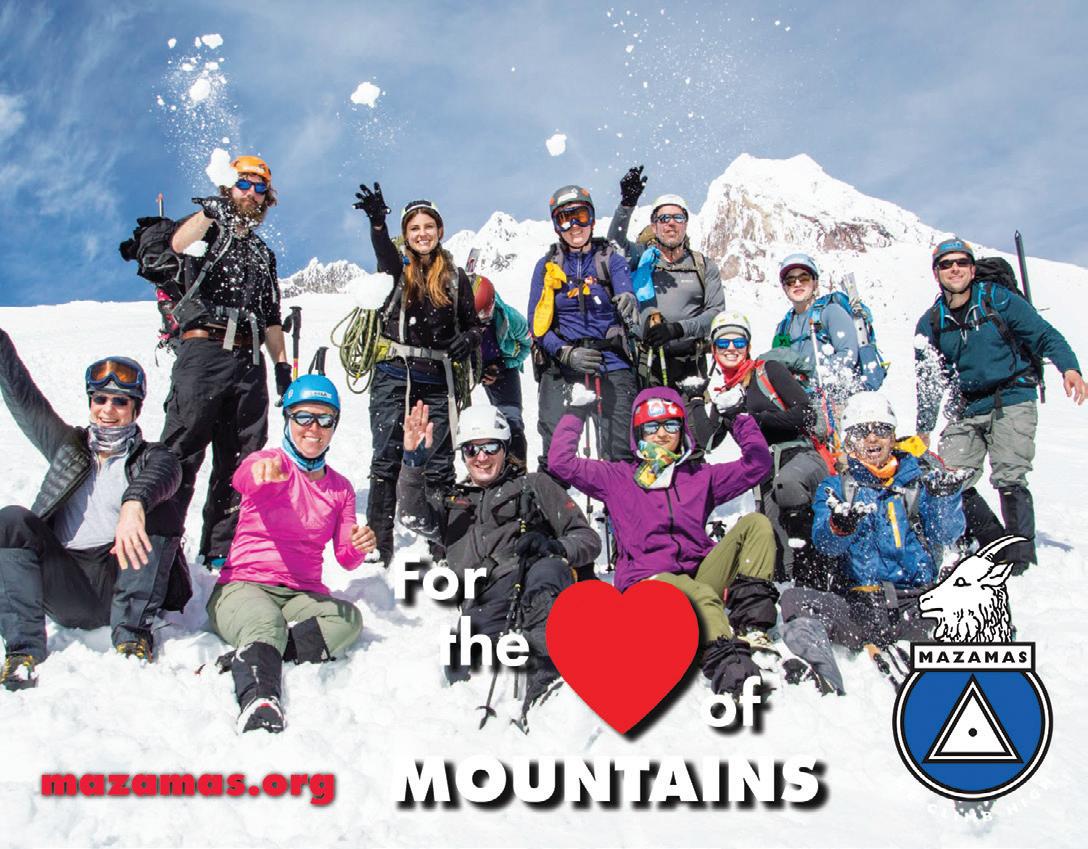
40 MAZAMAS Mazama Periodical Postage Paid in Portland, Oregon Mazamas® 527 SE 43rd Ave. Portland OR 97215 www.mazamas.org
Above: BCEP students relax after a day at Mt. Hood, Spring 2021.
Photo by Teresa Dalsager.

















 Mathew Brock
Mathew Brock

 Library & Historical Collections Manager, Mazama Bulletin Editor
Library & Historical Collections Manager, Mazama Bulletin Editor





















 by Claire Tenscher
by Claire Tenscher



























 by Elise Englert
by Elise Englert







